Mind the Product London 2019 – Live!
Mind The Product London 2019 started with a big bang! Our Product Specialist, Andrea, was on the ground live blogging the day’s highlights.
Henrik Kniberg
Coach, Mojang
Henrik has a fascinating background, previously having worked as a game developer at Lego, coach at Spotify, and part of the Minecraft team.
A great first question was proposed to the audience: How do we get makers to build great products that are useful?
Let’s start with what makes an awesome product.
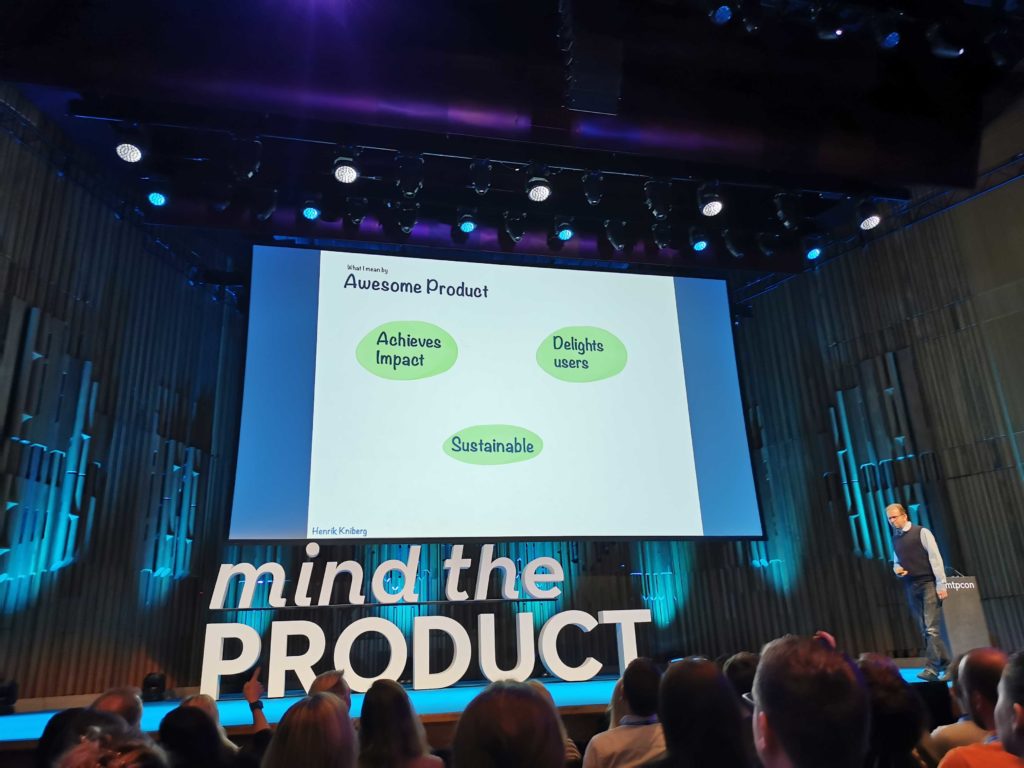
With that in mind, Henrik presented two examples of companies he’s worked with: Lego and Minecraft.
Lego: A 250 person project, 4000 man hours wasted of work for a project that was shut down two years later!
Minecraft: Built by two people, with the first public release in six days, and 100 releases within first year. They took all feedback and iterated constantly, before selling to Microsoft for $2.5 billion.
Great companies screw up, but learn from their failures. Mediocre companies will continue making the same mistakes.
So what was the difference?
The team at Minecraft was able to do faster iterations allowing them to pivot quickly.
Frequent releases = easier planning and less frustration.
YSK: At ProdPad we release twice a week every week. We also don’t focus on timeframes, we focus on listening to our customers and shipping things based on feedback.
And then came a warning: drop the “MVP” and focus instead on “MLP” (Minimum Lovable Products). Show things that are still usable and build trust with customers as you go along. Changing the language with stakeholders can make a world of difference.
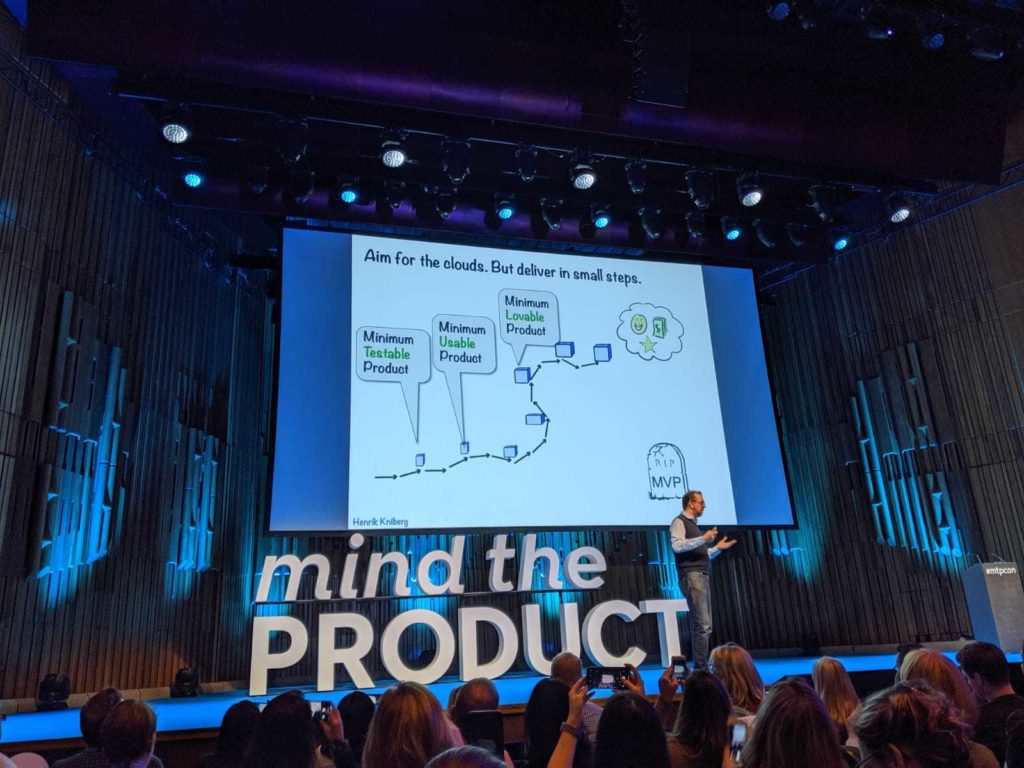
One of Henrik’s last points was making sure team communication was clear and transparent. Make sure your teams are working and communicating with each other, learn from your mistakes. Don’t ship burnt toast!
Misalignment can be a problem if there’s no cross-team transparency. You could end up working on the same problem with two different solutions (which have already been completed). This leads to time and money wasted.
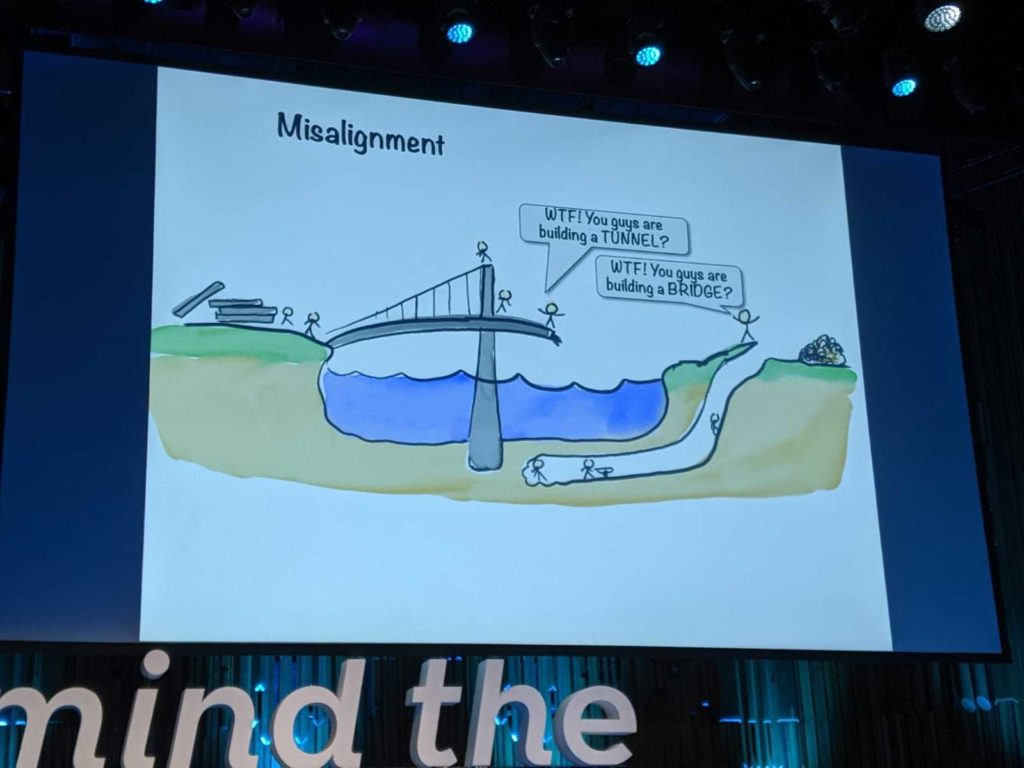
How can you fix this?
Demo within teams, show what you’re working on. Allow teams to show what they’re working on and most importantly, make sure they’re talking about these findings to each other.
YSK: The ProdPad team demos stuff to each other all the time. Product will also give a specific demo to the customer team and answer questions about competitors, functionality, market interest.
TLDR
- Release often
- Get real user feedback
- Slice the elephant
- Autonomous teams
- Radical transparency
- Curiosity > Pride
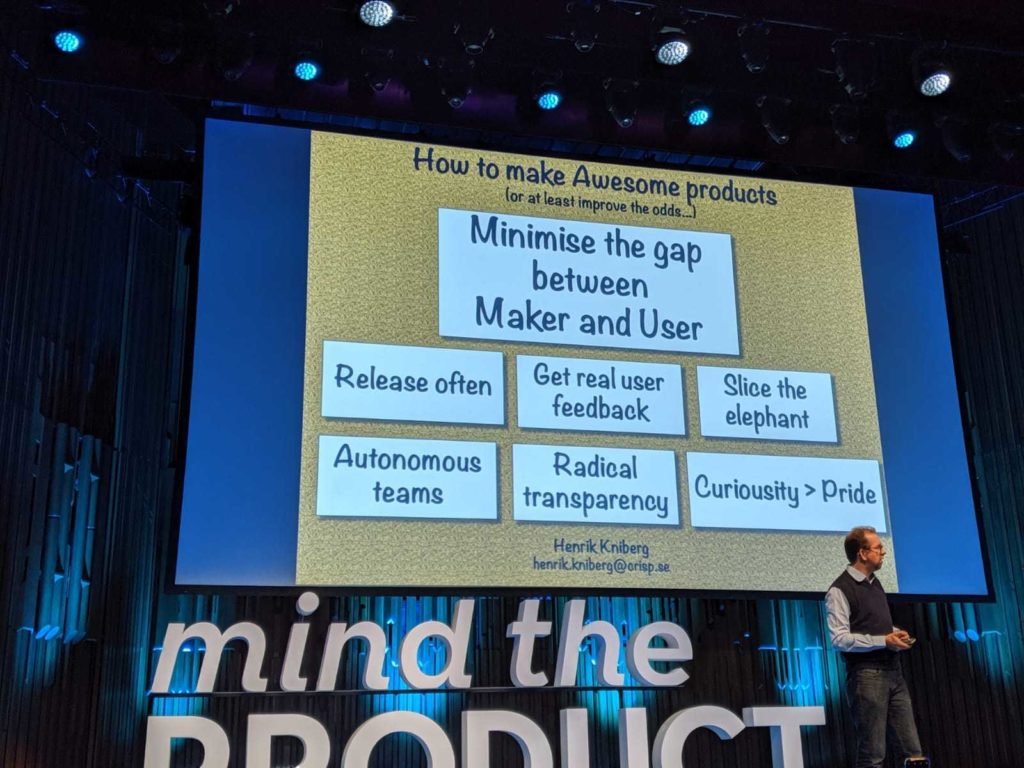
Andy Ayim
Managing Director, Backstage capital
Andy started out with a very thoughtful quote on the Mind the Product stage:
“What does inclusion mean in practice?
Ask who’s not in the room. Who’s perspectives are not being represented at that time.
Who’s voices are not being heard?“
He then proposed mental models and frameworks for thinking.
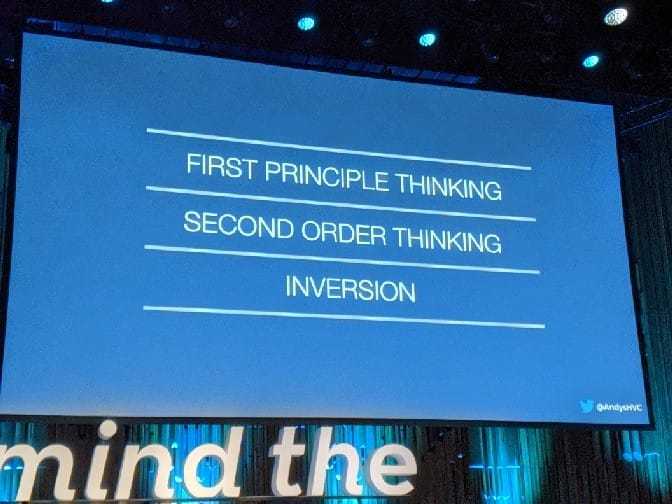
So what are mental models, anyway?
- They challenge you to keep things simple
- They help you reframe problems
- Aid to help you think differently
First principle thinking
Answer the simple question of how do we solve this problem more efficiently if we start from scratch?
A first principle is a basic truth that cannot be deduced any further.
Start with fundamental questions. What:
- Do we know is true?
- Do we know has been proven?
- Are the facts that cannot change?
Second order thinking and unintended consequences
Try to think through the problem and the consequences that may arise from the solution you’re looking to implement.
Second order thinking is useful when thinking of long-term goals.
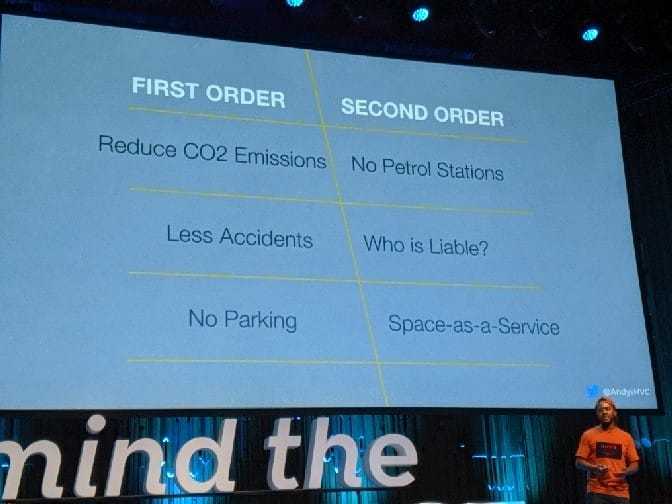
Inversion
Inversion is about looking at problems backwards.
Think about everything that can possibly go wrong in order to move a product forwards.
Take that worst case scenario and use it as a project inspiration to figure out your solution. You’ll end up with a list of risks you can eliminate and manage.
Five key things to help you get started
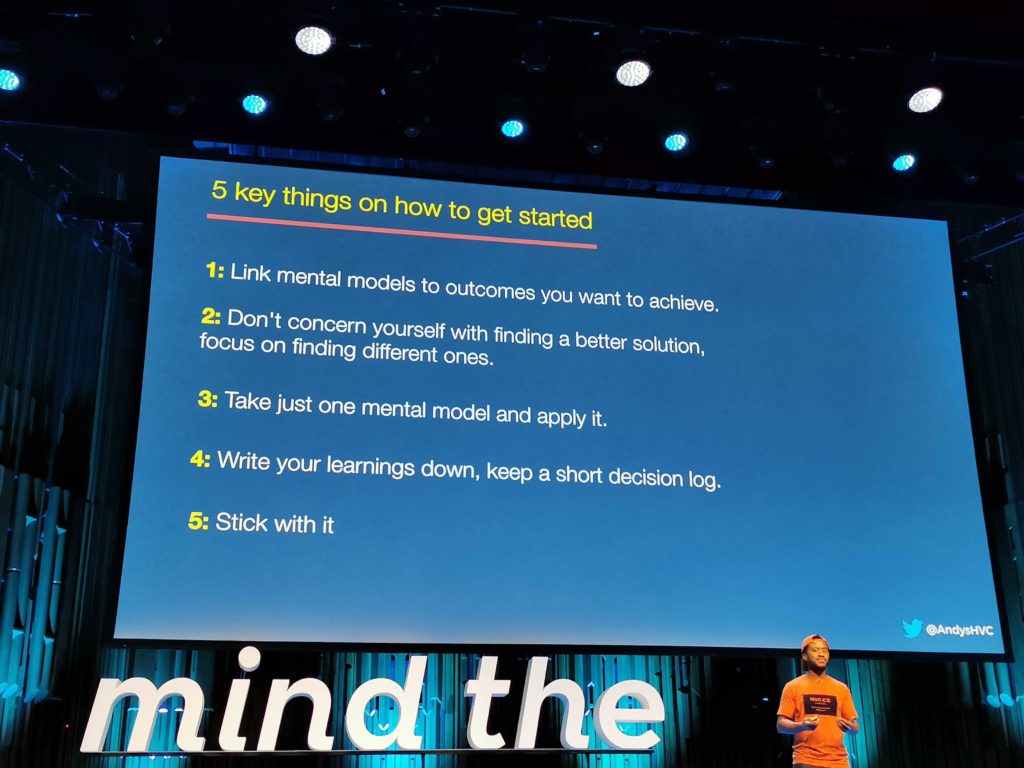
Our favorite recommended reading: Daniel Kahnemman’s Thinking Fast and Slow.
C.Todd Lombardo
VP Product and Author of Roadmaps Relaunched
Are we building the right things?
Let’s talk about that.
Today’s talk is all about product research with C.Todd.
We’re currently meeting Bill Nguyen, a serial entrepreneur who, amongst all of his achievements, sold a company for $850 million – before the age of 29.
Bill is awesome.
Bill also thinks he doesn’t need to do research (my inner product manager is also freaking out with C.Todd about this!).
I think we know how this turned out.
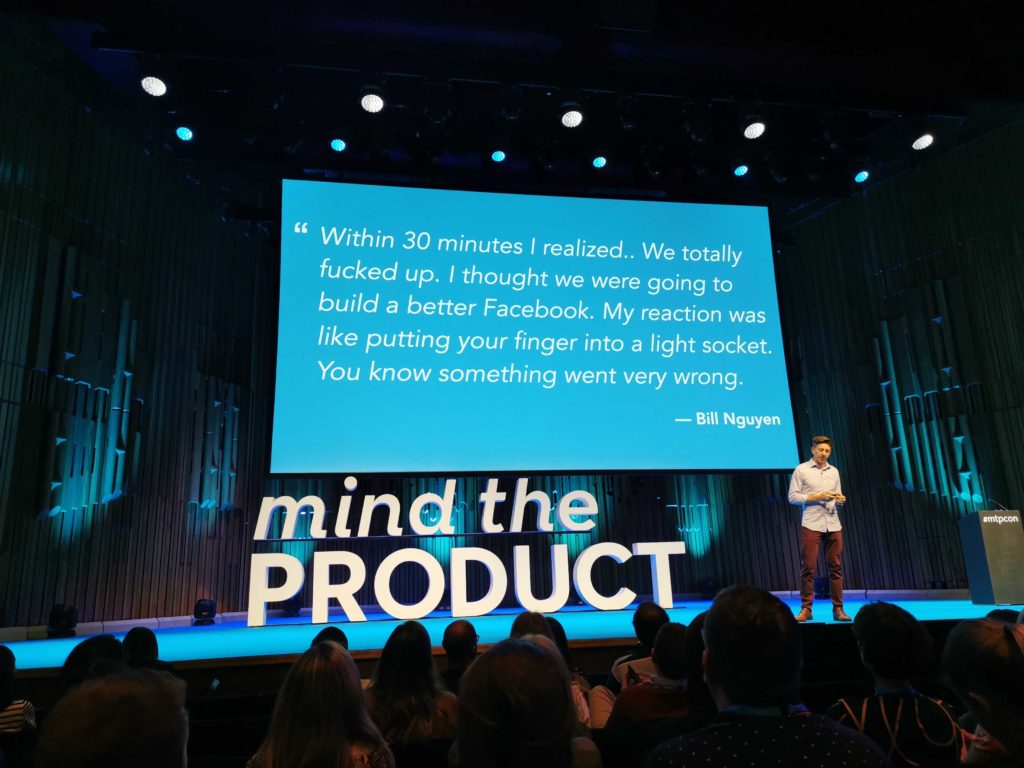
Why do products fail? Above all, bad product research. But do you want to waste 45% of your resources? If the answer is no, do product research?
But what is product research?
It’s not just about evidence, it’s about experimentation.
We have user research, market research, product analytics. Product research is the intersection of all three. We can’t just be one, we need to be all of them.
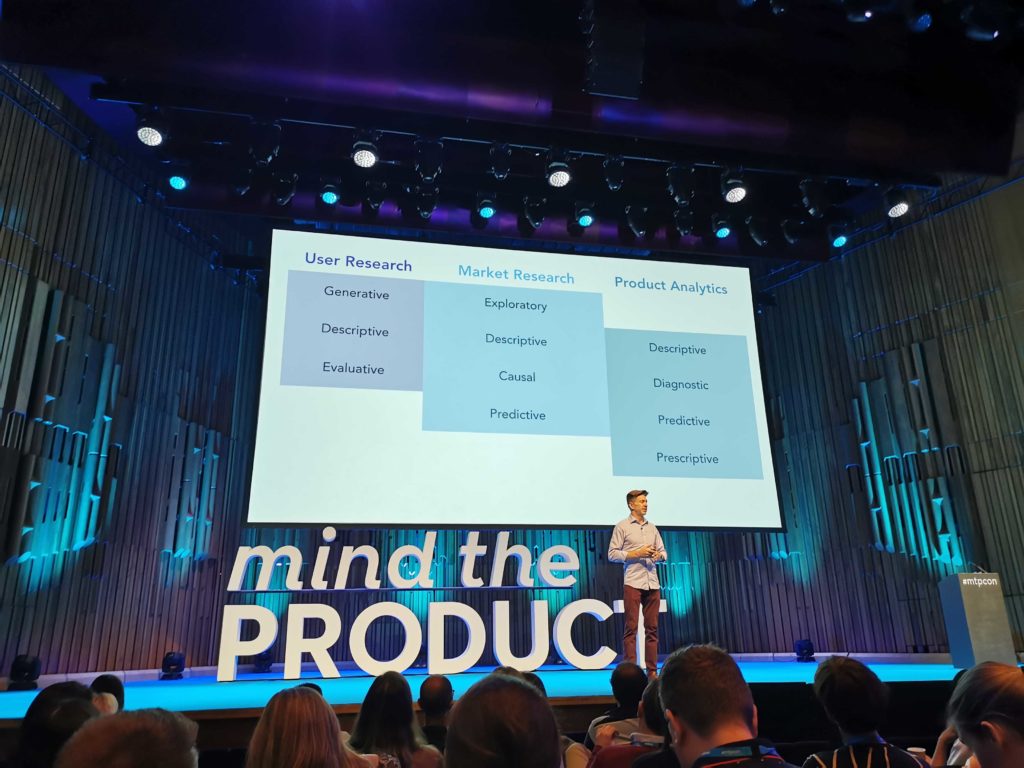
Rule #1 Prepare to be wrong, because you will be
Check your ego, you will be wrong and that’s ok.
In order to be wrong you need to accept that there are things that you do know, but also that there are things you don’t know.
Rule #2 Get curious with your data
Start with what you’ve got, generate questions, and settle on a research question to answer.
What you ask and how you speak matters – a constant throughout this conference so far. If you ask people to predict their future behavior, it will only validate your ego, not whether you’re working on the right stuff.
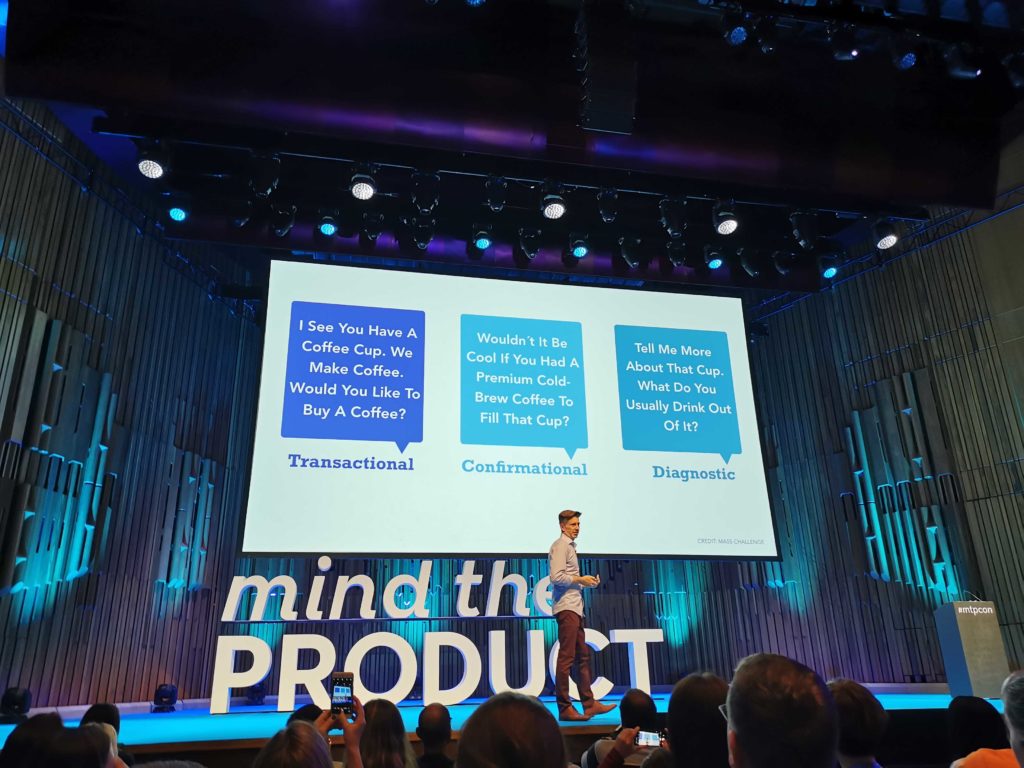
Based on how teams ask questions, diagnostic teams go up the charts and accelerate in growth. They’re trying to solve real problems for real people, not trying to confirm assumptions they already have.
Rule #5 Interview and ask questions
We’ve gone from two to five, maybe we should be asking questions.
What people say is not as telling as what people do. Humans are unreliable (Sorry, humans).
Rule #6 Go beyond the interviews
Interviews only tell you so much, walk in their shoes. Try and visit your users where possible, watching them interact with your product can give you a world of insight.
Rule #8 Inspire actions through insights
We’ve missed a rule, but this is so good we don’t even care.
Don’t just write a report, facts don’t move people. Stories and co-creation do.
We are now meeting Jeff. Jeff is from Appcues, and we should all be like Jeff.
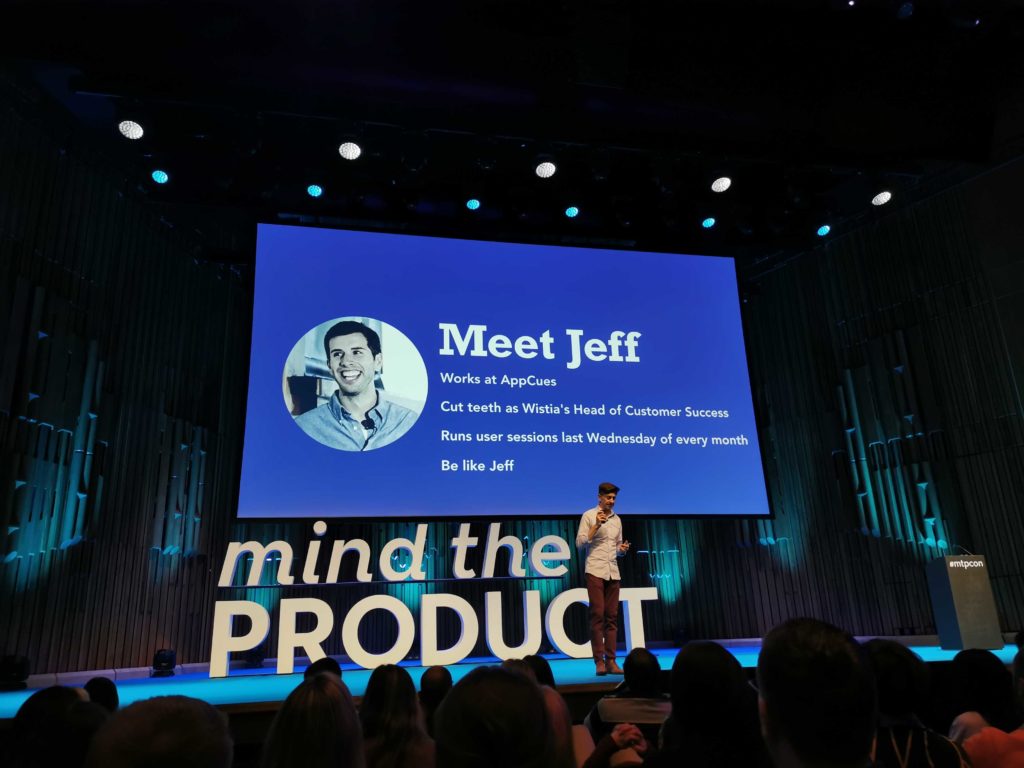
Why?
Jeff runs user testing sessions the last Wednesday of every month.
YSK: The ProdPad team runs constant user testing sessions and gathers feedback from our community. We’re with you, Jeff!
Rule # 9 – Make it a habit
It’s all about continuous discovery.
We’ve also just found out why the numbers don’t match up, there’s a lot more rules, but C.Todd has cherry picked the most important for us.
Kriti Sharma
Google Scholar and UN Advisor
Kriti built her first robot at the age of 15, and since then her mission has been to solve global issues through AI. Recently named 30 under 30 in the Forbes list!
So what did this robot do?
It grabbed a snickers at 3pm every day.
Nowadays though, Kriti is working on a robot with better eating habits. The robot aims to have engaging, long conversations with people. It takes information from various news sources in order to hold these conversations, which is massively impressive.
Which leads to the question… can AI create a fairer world?
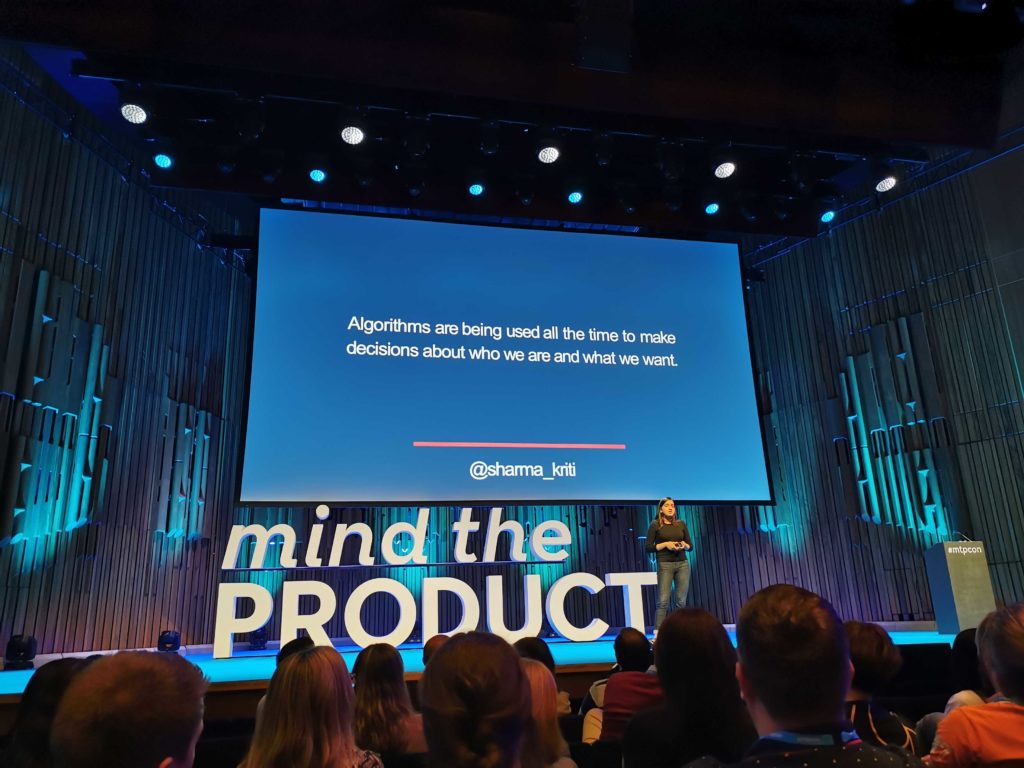
Kriti’s talk is touching a lot on product ethics, and whether or not these algorithms are working with a human touch, or solely based on gathering data which can cause bias and have unintended consequences.
A human-centered AI, says Kriti, can actually help solve problems better, and as an unintended consequence with her own product, resulted in humans trusting machines more than other humans.
Kriti is taking a bit of a dive at how humans interact with computers. Why does a cat with a jetpack have more credibility in the tech world than a girl with two computer science degrees? (Major applause from the audience)
And now we look at AI systems. Google Home, Alexa, even Cortana – what do these all have in common? All of them have female voices to do things for you. Could this have been avoided? Kriti suggests by asking the right questions and involving members from different backgrounds a lot sooner, we could spot these issues before a product is released.
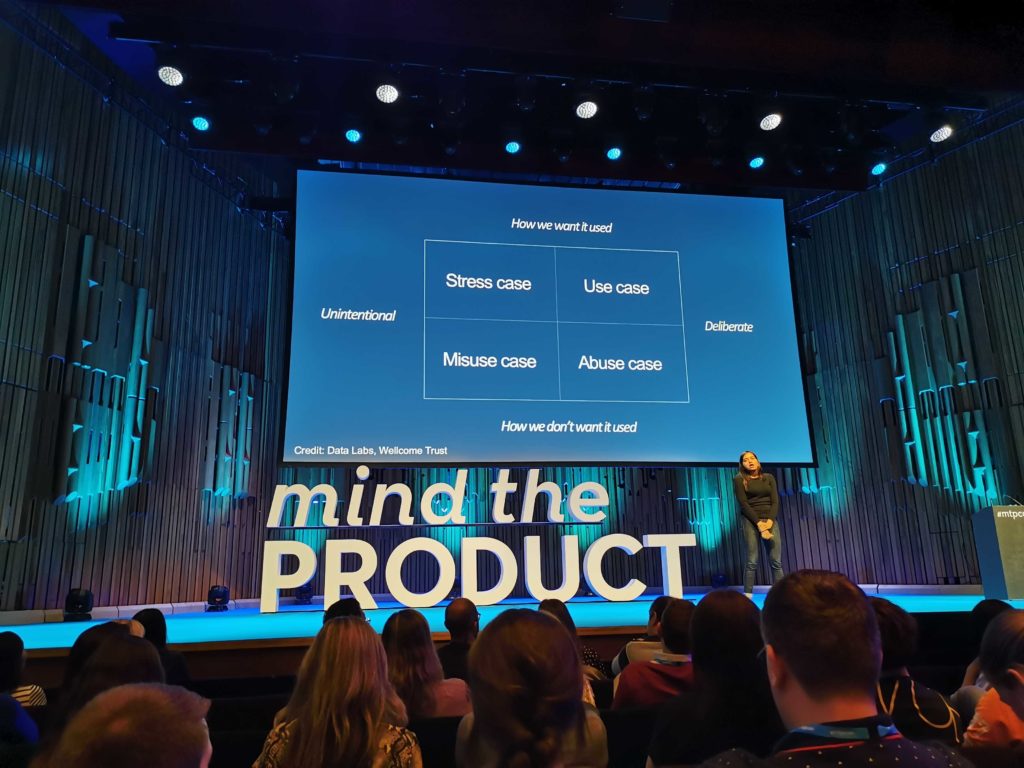
How can we avoid these biases and unforeseen consequences?
You can use a canvas-style document to allow you to answer those questions. Is there a sustainability aspect to your product? What problems are you trying to solve?
A few tips on building AI
- AI should reflect the diversity of the users it serves
- AI must be held to account – and so must users
- Reward AI for ‘showing its workings’
- AI should level the playing field. It should be developed for the common good and benefit of humanity
- AI will replace, but it must also create
On the bright side, we can hope that when the machines take over, at least they will be nice.
Jonny Schneider
Head of Product Strategy and Design, Thoughtworks
From Melbourne, Australia
Is this what design thinking looks like?
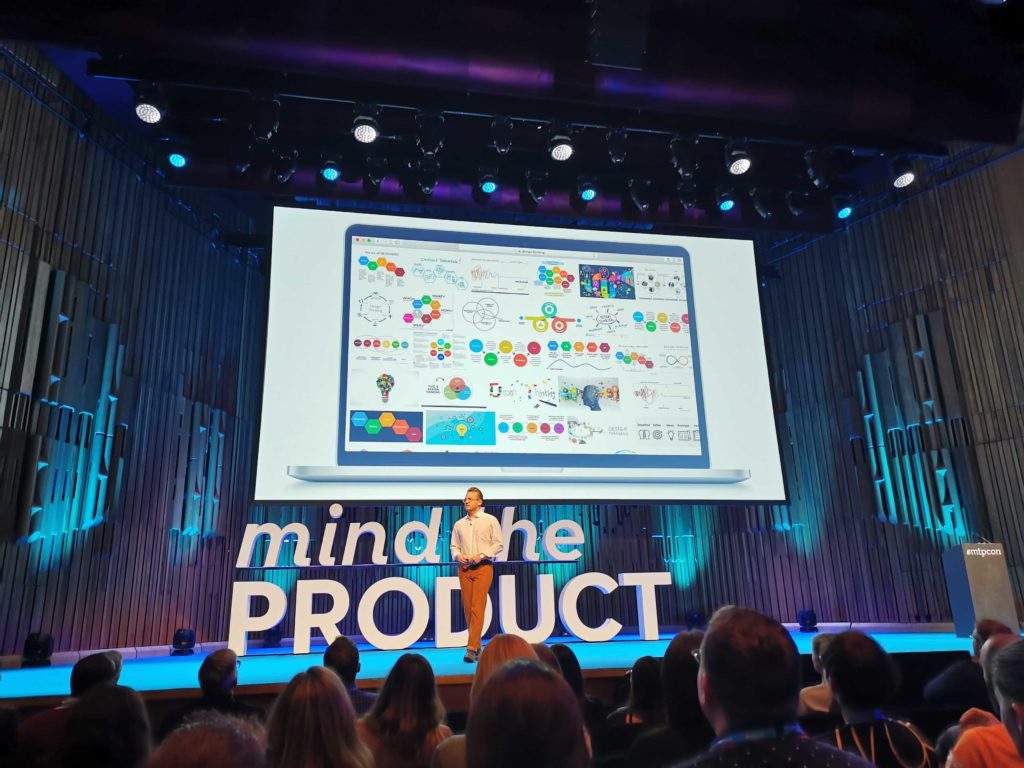
Jonny tells us no.
Design is an ability. Process only helps with getting started. It’s about empathetic learning, learning from others, fast experimentation and optimizing systems of work.
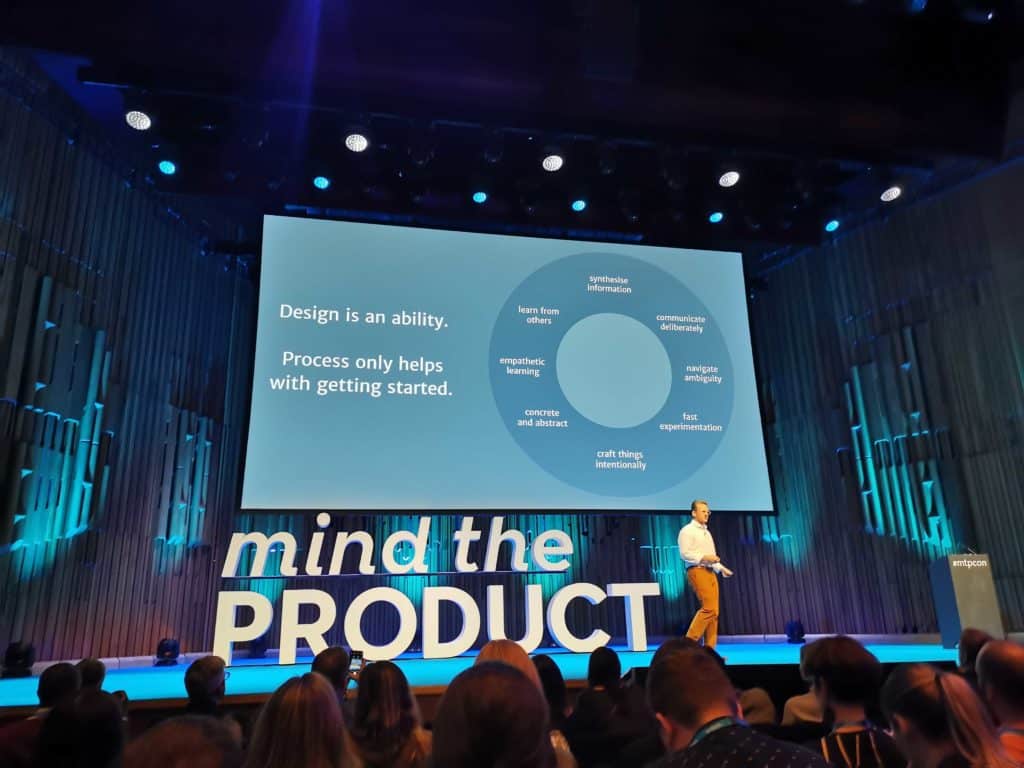
Agile is not just about responding to change over following a plan. Agile came out of trying to do delivery and software better – it’s how we adapt to change as it happens.
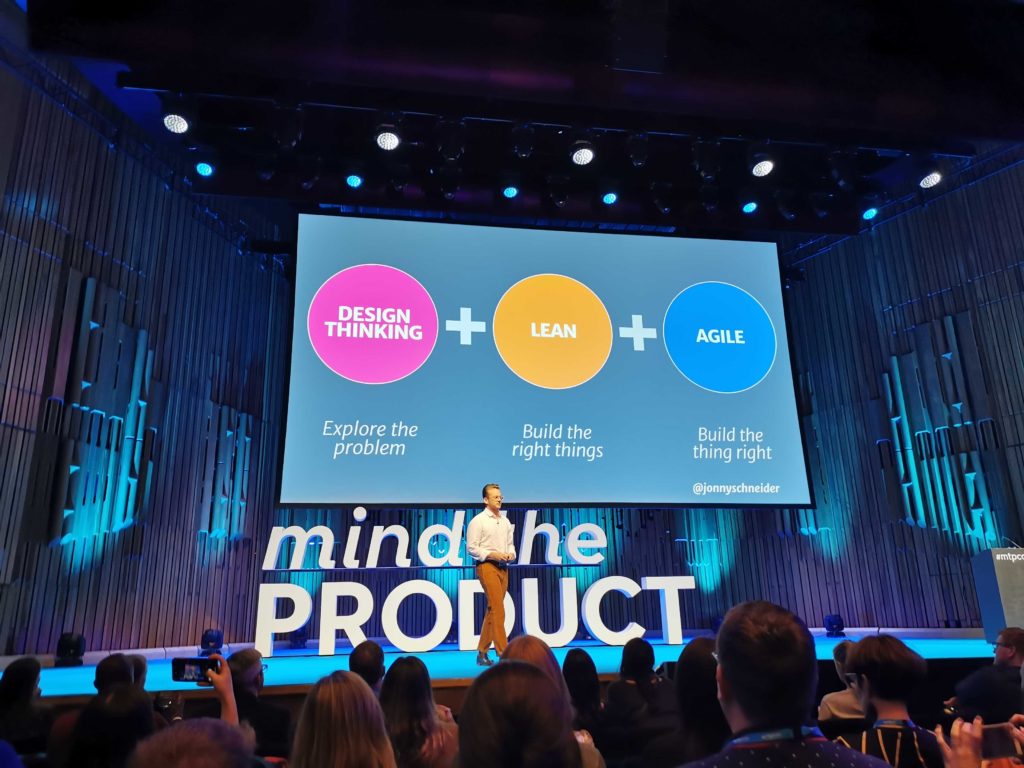
How do we bring these things together in meaningful ways?
The bad news: You have to figure it out for yourself, but that’s because there isn’t a one-size-fits-all.
The good news: Jonny can give us a place to start!
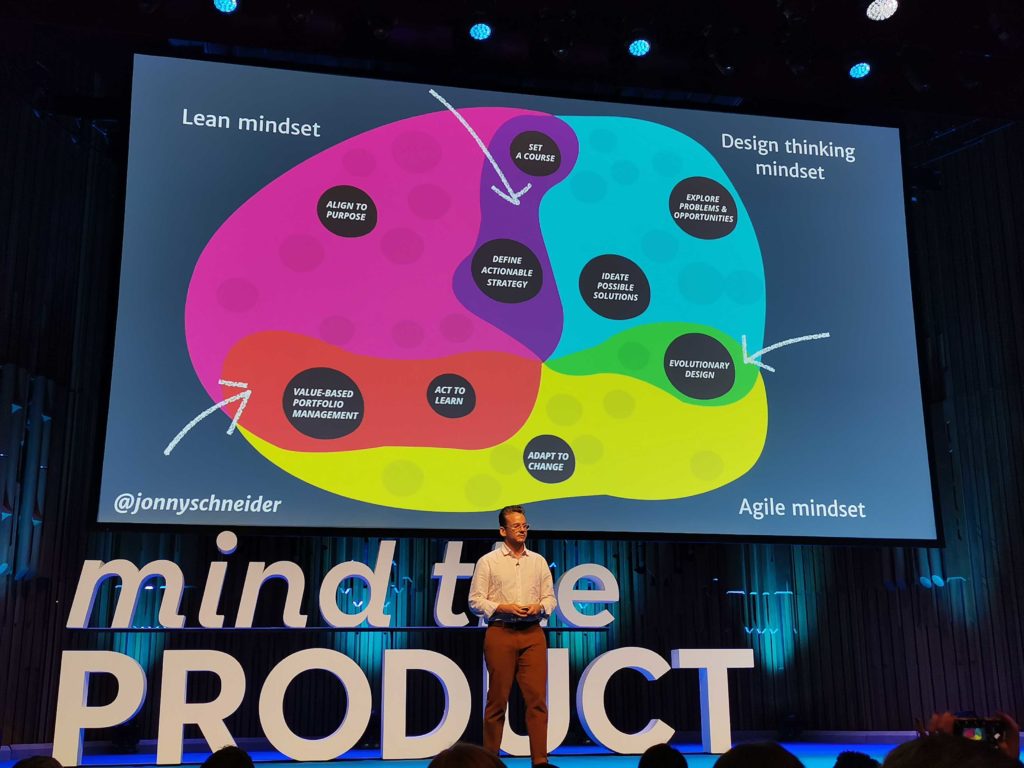
1- Continuous learning is the new competitive advantage
The cost of creating software has reduced over time, but complexity and uncertainty has increased. Try to validate stuff before putting it out in the market – it can only serve you as an advantage. Nowadays experimentation is a lot easier. Continuous learning does not replace strategy, but it’s there to support it. Focus on confidence, not certainty.
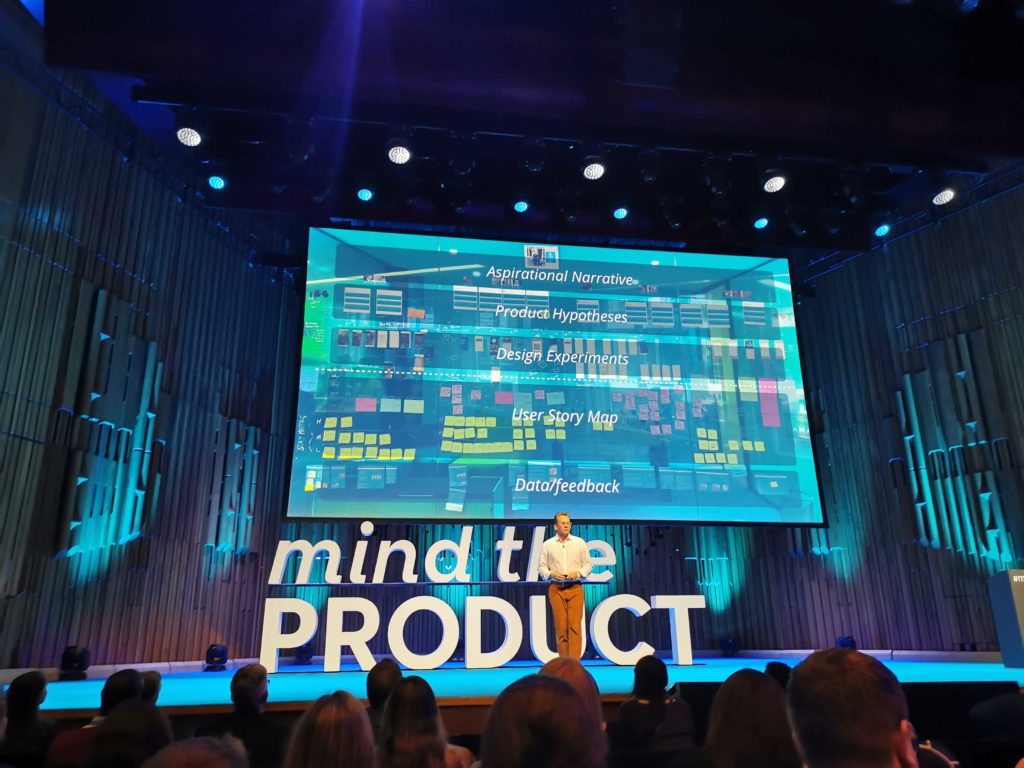
2- Design the right experiments to learn the right things
Chiming in with what other speakers have said, Jonny warns us of making assumptions. Are the problems you are focusing on worth solving?
What type of learning will each experiment you run provide you with? It’s all about understanding the context of the problems you are trying to solve.
Most importantly – is there a demand for the problem you are aiming to solve?
When thinking about experiments, think of cost vs confidence.
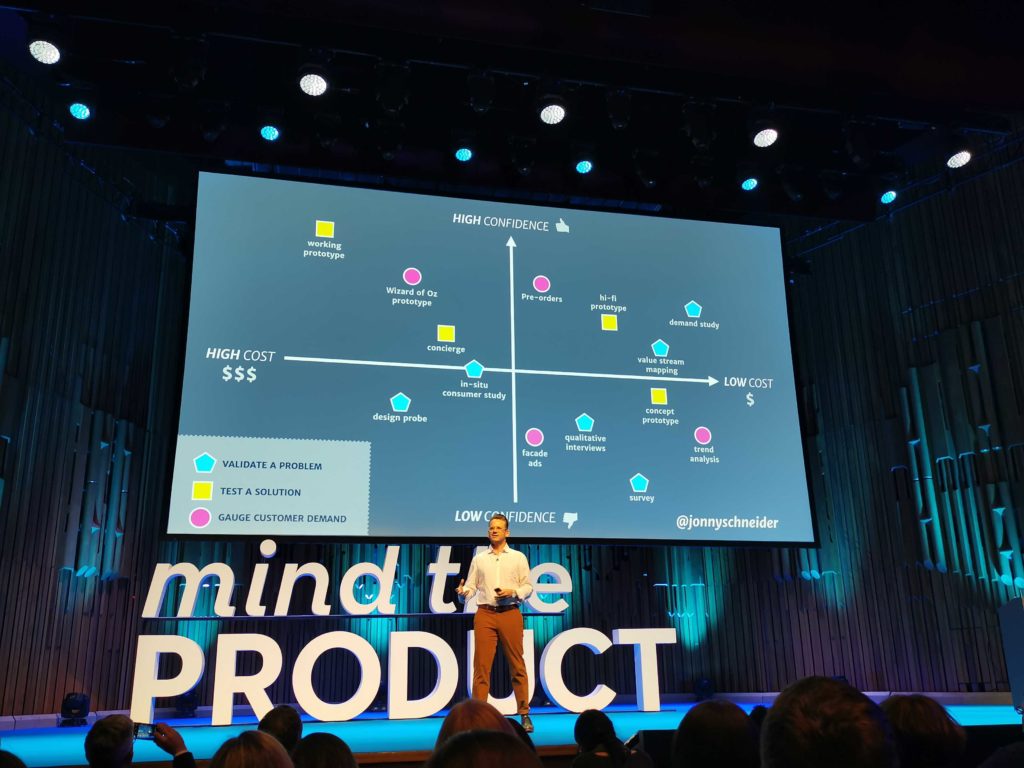
3- Measure only things that contribute to decisions
Are you measuring the right stuff? Don’t let yourself be fooled by fancy data. Remember that whatever you choose to measure, those items are related to goals. Focus on impact on objectives.
A starter template for clear metrics from Jonny:
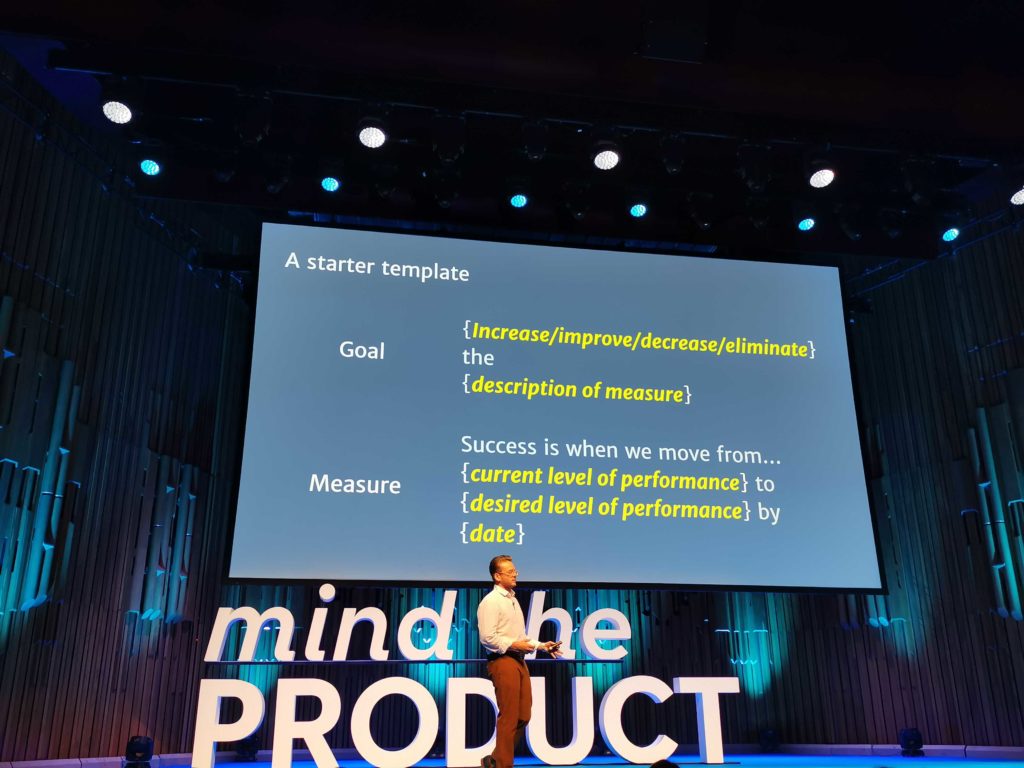
4- Solve for next order problems
Problems just have a way of unfolding on you.
“Different people from different parts of an organization will have different perspectives and will stand at a different distance from where the action is.”
It’s all about bringing the right people together.
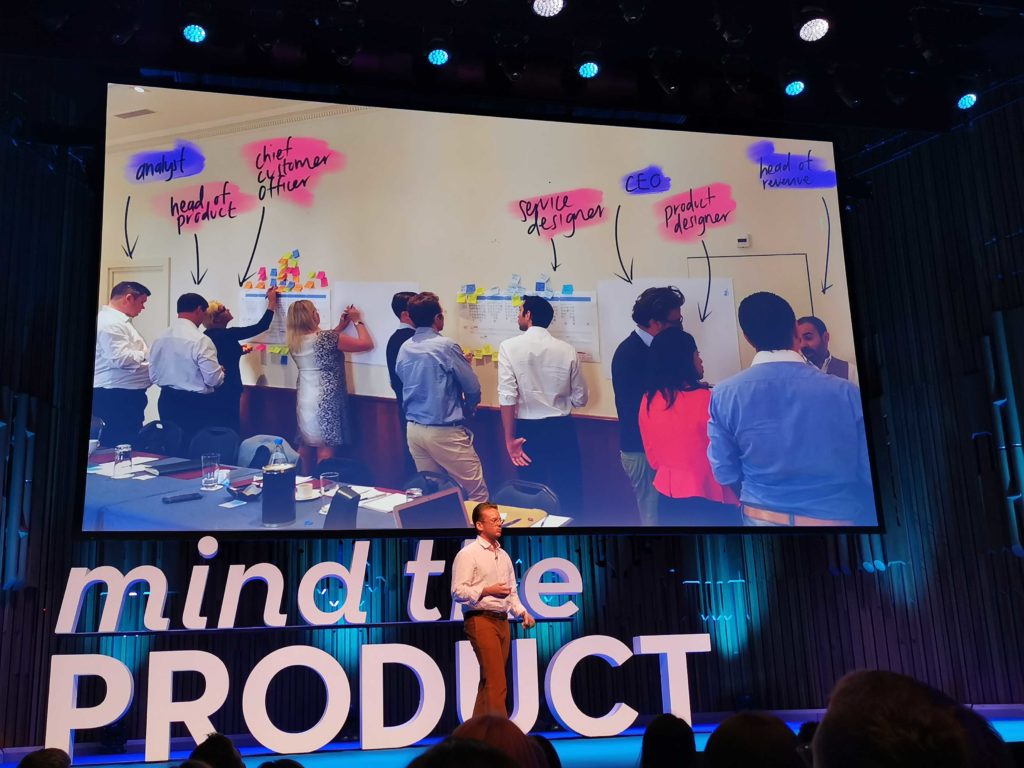
When you do this, you can bring together the different elements of a [good] strategy. As a product manager, you’re there to enable people to come together to figure this out as a team. Most importantly, learn from the things that don’t work and apply that to your iterative process.
Kate Leto
Product Coach
What does it mean to be successful in product management? Kate is here to tell us.
In 1918, Charles Riborg Mann was asked to run research on engineering education in the US. Was the education preparing young men (only) for success?
Yes, 1918.
Mann sent out a survey to 30,000 people (wowza!) and asked them to prioritize criteria for job success. Only 7k people responded.
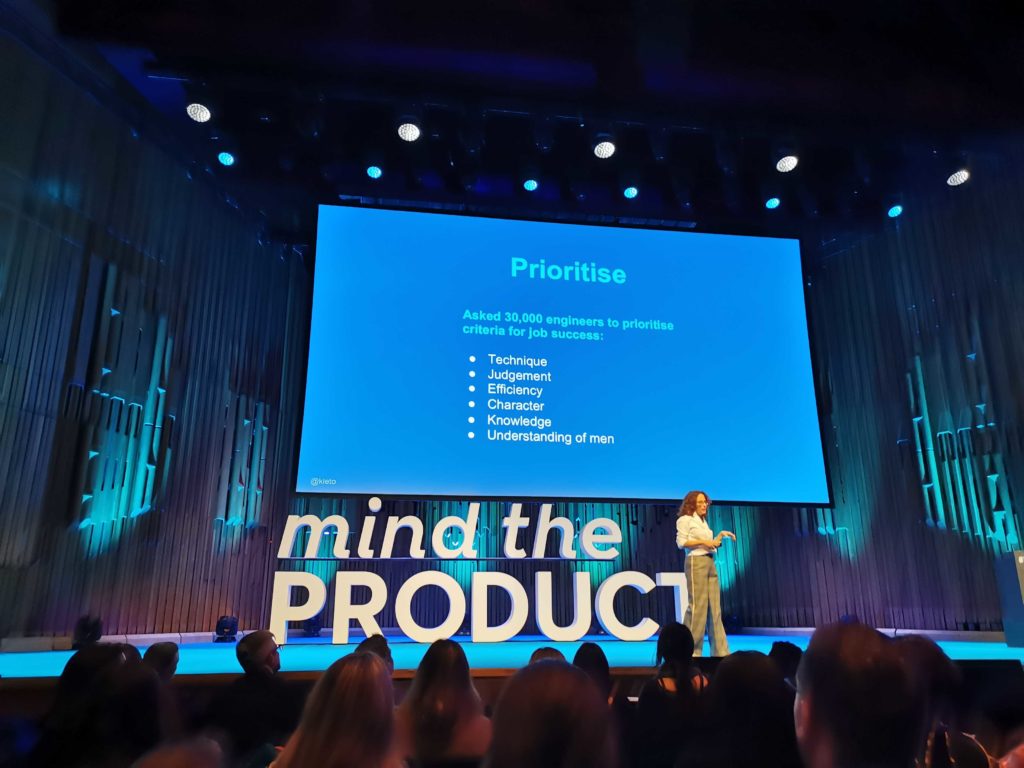
At the time, character was the most popular answer. The research was validated and the conclusion was that character/personal development was necessary.
We flash forward 101 years… and here we are at the Barbican!
The vocabulary in the last 100 years has changed, of course. From “personal development” to “EQ,” see how things have changed below:
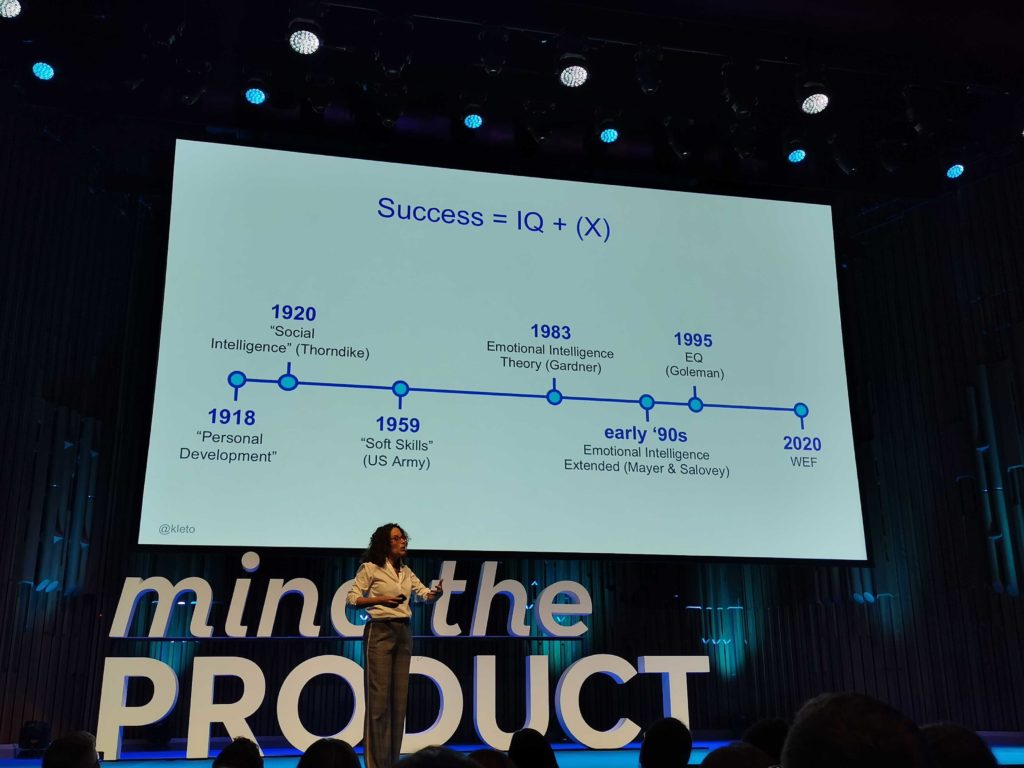
By 2020, the expectation is that most employers will be looking for emotional intelligence as a skill.
Don’t know what that is? Kate explains with the following chart:
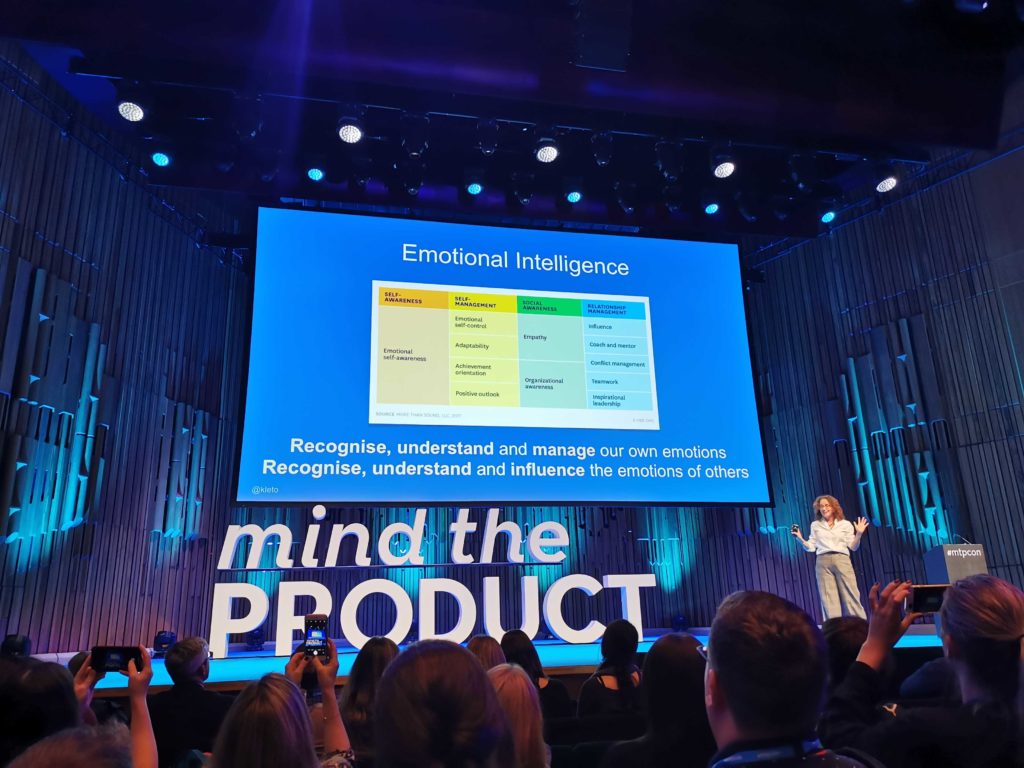
Individuals with higher emotional intelligence make up to 30k a year more.
Teams with higher self awareness can deal with conflict better, are higher performing, and coordinate better with each other.
Unfortunately, most conversations with companies don’t focus on emotional intelligence as much as they should. However, is the disconnect necessary?
EQ is related to building a great roadmap, says Kate.
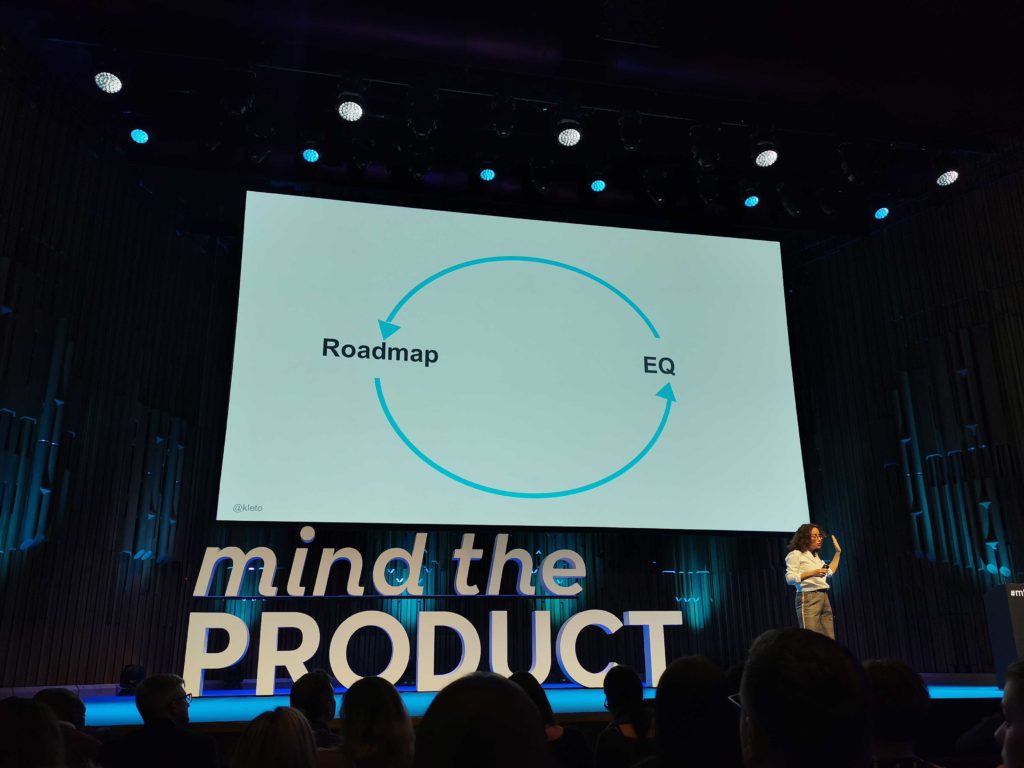
As a product community, it’s time to take a look at our narrative in success and product management. It’s time to reframe that and realize the things we do are important, but they’re taking up too much space in conversation. We need a bit more space for emotional intelligence. After all, emotional intelligence powers our behaviours behind the things we do.
A good area of focus to get started is how we hire teams
Bad hiring decisions are bad for us, our teams, and our organizations.
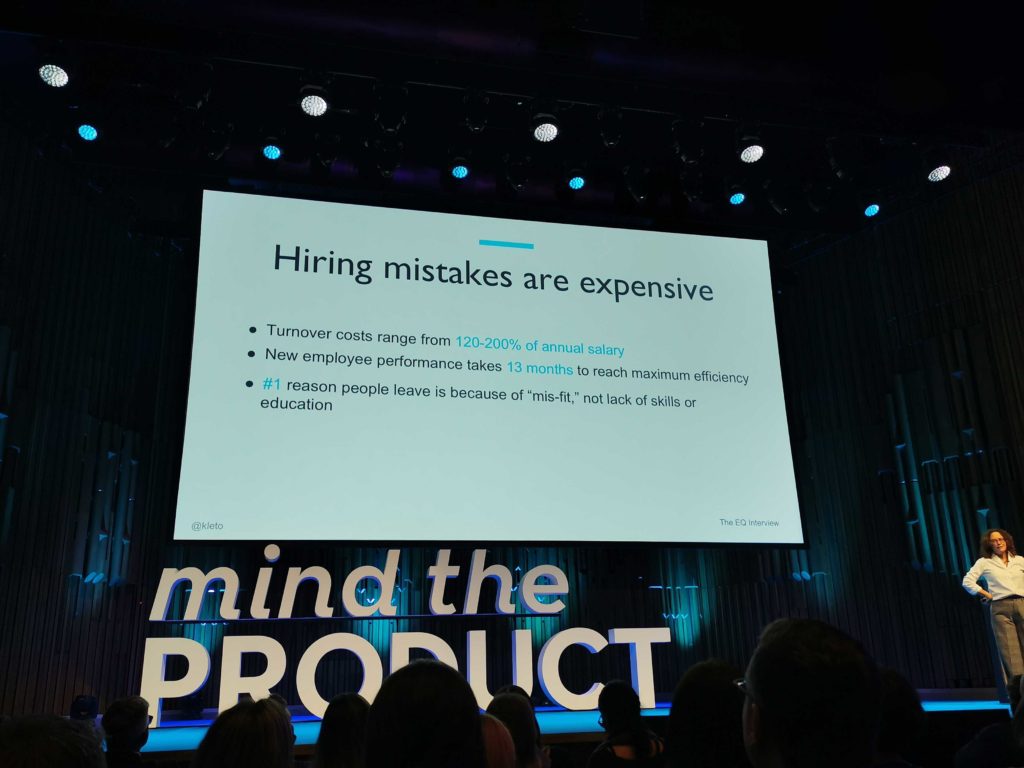
People leaving companies has nothing to do with skills or tools, but rather not fitting in with the culture of the organization.
A few tips on person-organization fit
1- Build a role that matters
Don’t hire like this!
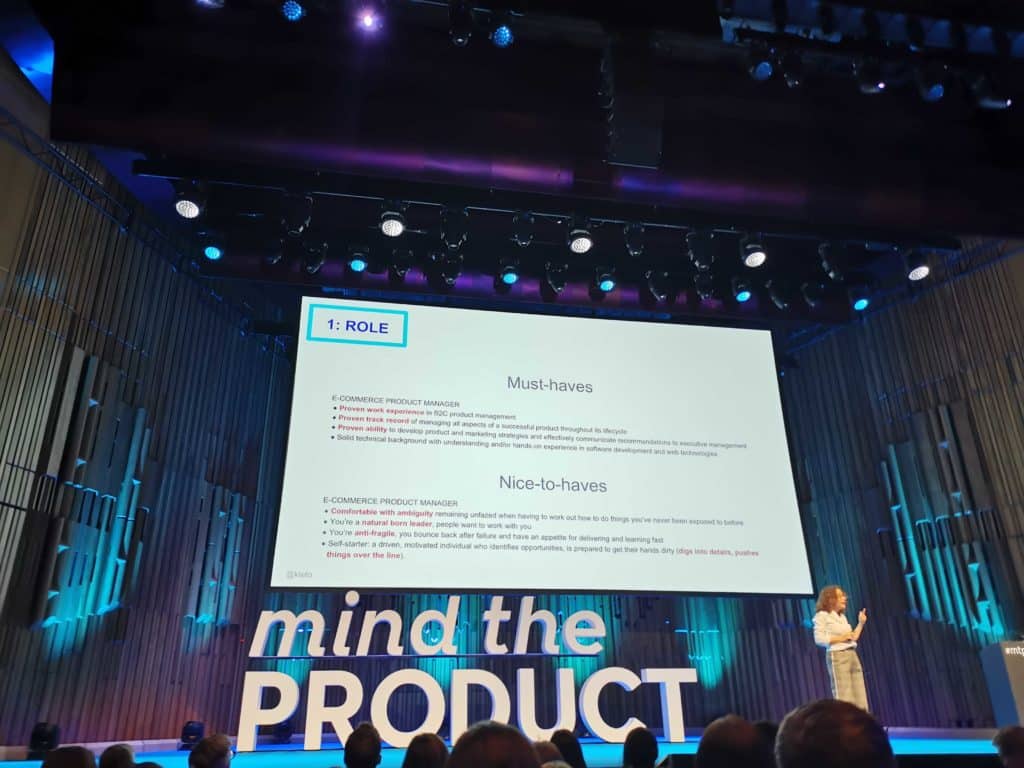
People aren’t just born ready to lead. Common guys!
This isn’t a real person, it’s just a unicorn!
Hire with emotional intelligence instead.
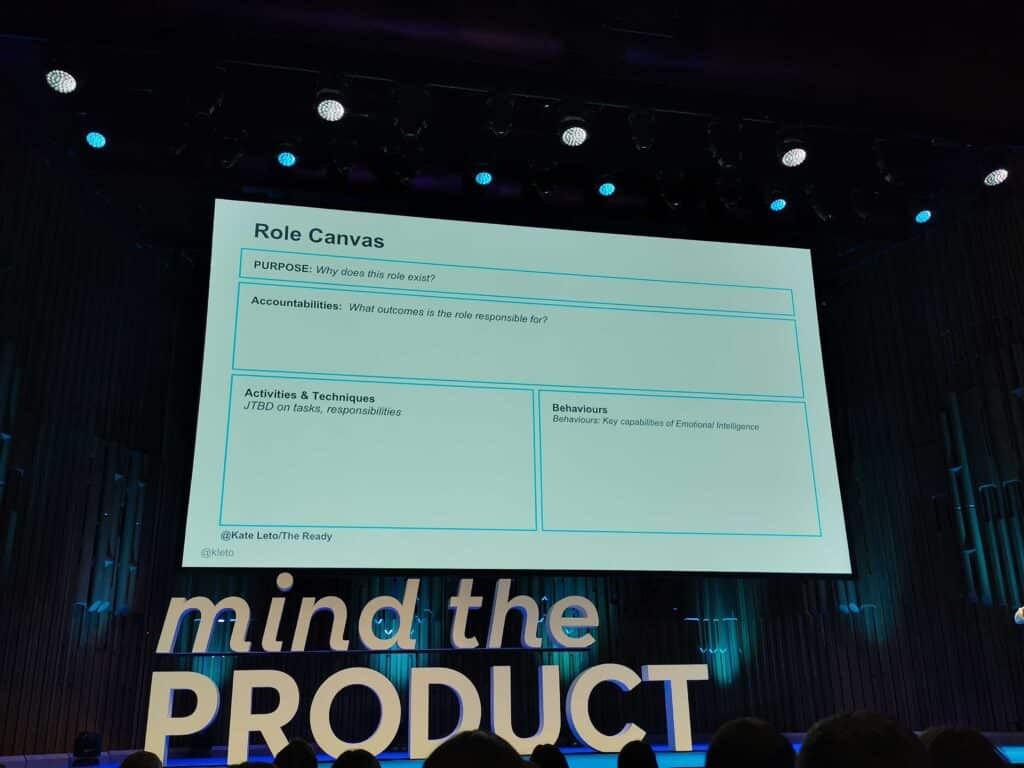
2- Broaden your interview techniques
Don’t interview in a way that makes you feel clever, it’s just satisfying your own ego. Ask behavioural interview questions instead:
- Tell me about a time where you handled a difficult situation?
- Have you ever encountered someone at work who was unreasonable – How did you respond?
This is designed for you to be able to listen, not to trick the interviewee. Focus on the narrative the candidate is sharing.
Further reading: The EQ Interview by Adele B. Lynn.
3- Hiring doesn’t end at the offer
Orchestrate long-term learning. 12 months down the line do a retro and evaluate the role in question – you can include the person you hired, too.
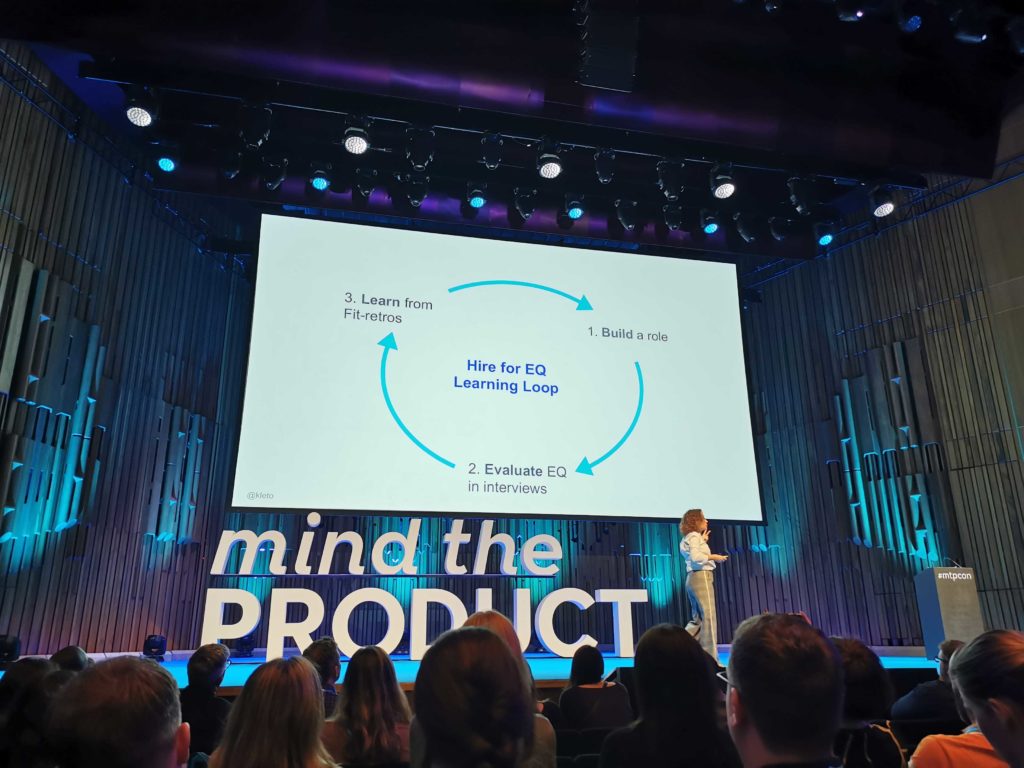
Most importantly, take a look at yourself. If you’re going to hire someone based on EQ, make sure you test your own EQ as well.
Lindsey Jane
VP Product @Monzo
The importance of being clear and how to do it.
Why clarity matters
Clear statements strips away the stuff you don’t need, and focuses on the items you can use to communicate a clear picture.
Noise vs signal – which ones does your organization have?
Too many organizations are so busy with filling out numbers and words that don’t mean and achieve anything – make sure you aren’t filling out the fields just to fill them up.
Be the batman in a field of princesses.
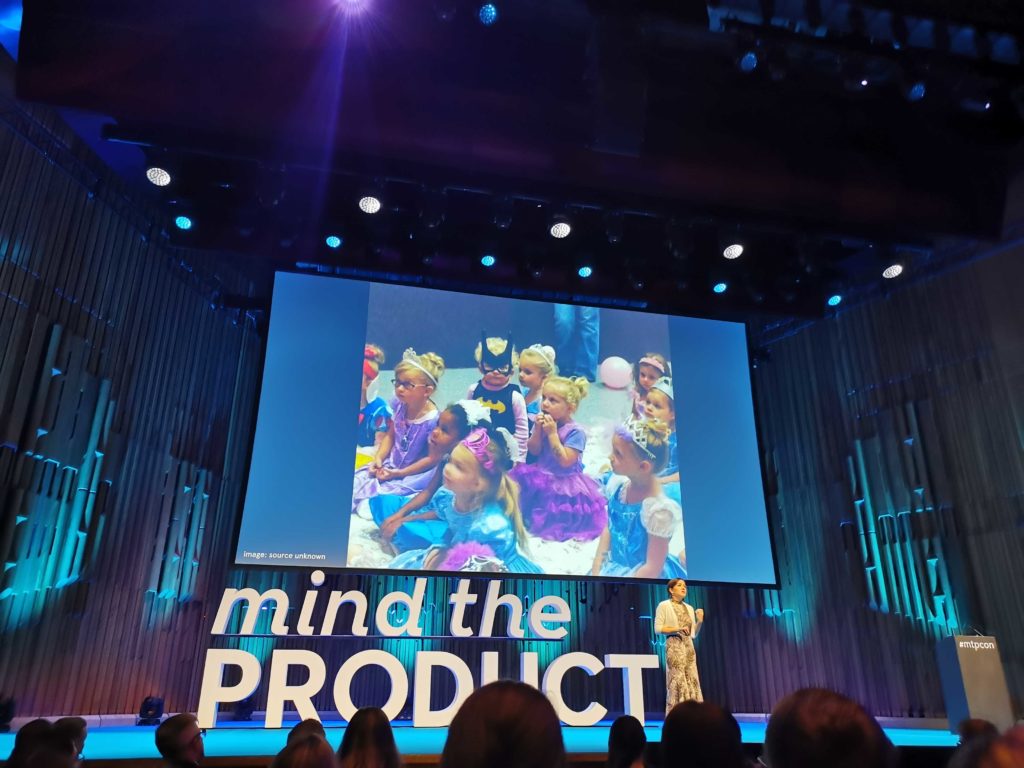
Take a position and be memorable.
We need fewer, better things. Have a clear idea that can be communicated well.
Critical thinking is the least taught, and most highly-valued quality in a product manager.
How to achieve clarity
If you’re going to be spending so much time writing, get good at it! It’s not about having perfect grammar, just be good at expressing yourself in a clear and coherent way.
You can’t hide a bad idea in clear, simple writing. Either the idea is terrible, or you will see a flowing of logic coming out of it.
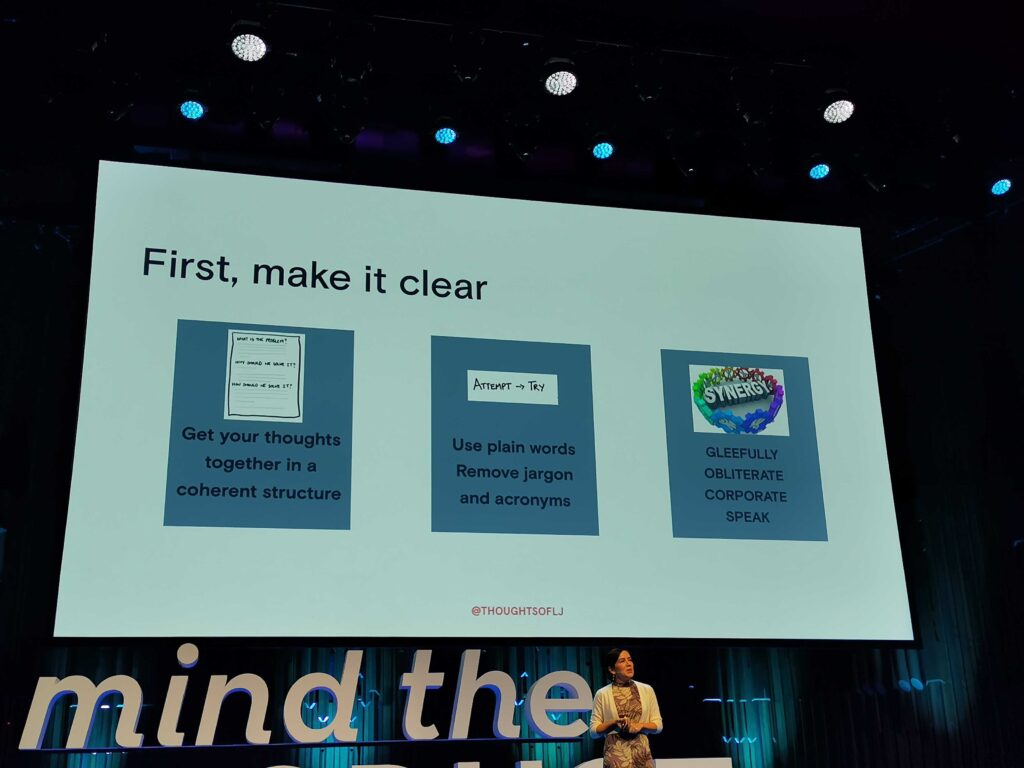
Bad writing is what clipart is to design. DON’T DO IT!
Make things brief
Brevity is hard, but very important. Remove every word or phrase that isn’t essential. Use short sentences and strong verbs – break up sentences if you can.
Most importantly – use the active voice.
“Once you’re left with something clear, you can see if the idea stands up to scrutiny.”
Share early and often
Transparency is key. It builds trust and amplifies ideas, helps find problems early, shortens feedback cycles, and invites unexpected expertise.
Whatever it is you’re working on, make it visible.
Diversity of thought will stem out of sharing something in clear, plain language that a wide audience can understand. You’re not simply talking to people that understand or are familiar with what you’re doing, but invites outside thoughts and improvements.
Is this scary? Yes! But that’s ok – when you do your best work and it gets criticized, it can only be a starting point to create better things.
If you don’t know where to start, give it a shot with your closer team members. Build up the confidence to widen out the audience as you go.
Do the hard work and be brave.
Ezinne Udezue
VP Product @Procore
With a background in product management with Bazaarvoice, Discover, T-mobile, Motorola and Nokia, Ezinne spoke to us next.
“A product manager’s job is to create the right conditions for the team to solve the right customer problem with the right solution, delivered at the right time to drive the right business value.”
That’s a lot of stuff, huh.
No wonder product management is one of the most stressful jobs.
At the heart of it, it is about people, product, and process.
PM competencies can be somewhat categorized into six main buckets.
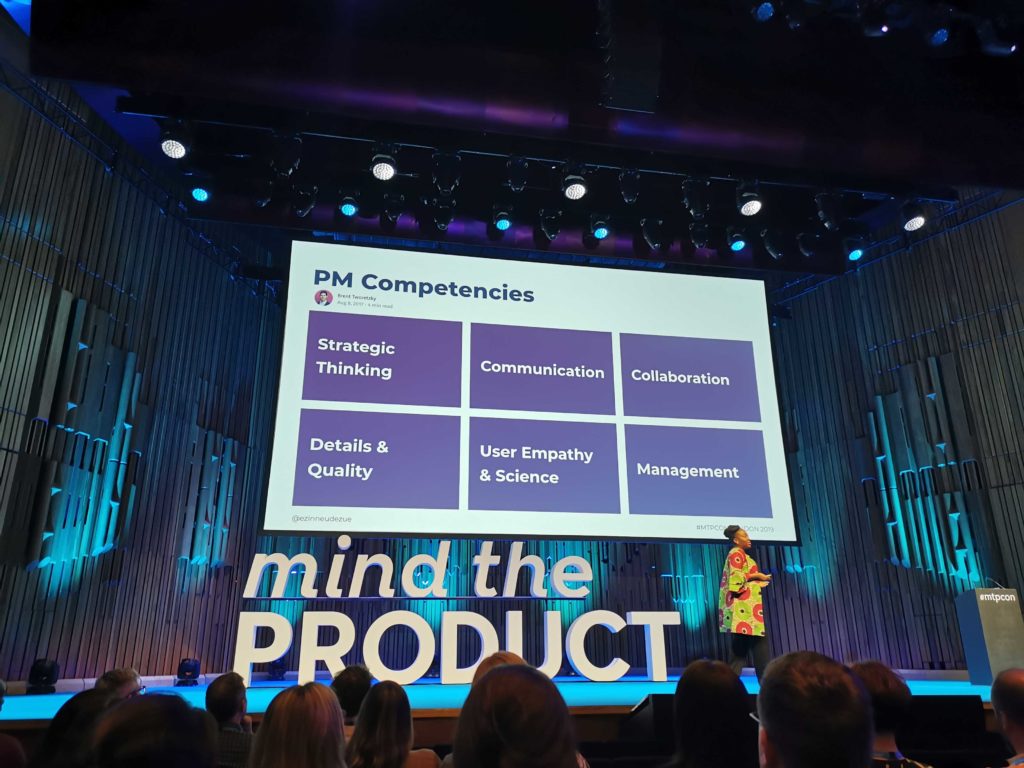
But what is next level?
Invest in understanding and valuing people
Bring together people with different backgrounds to make a better product.
We are in the process of a huge transition. Product is not just about the intersection of UX, Product, and Engineering, but moving towards success, marketing, and QA.
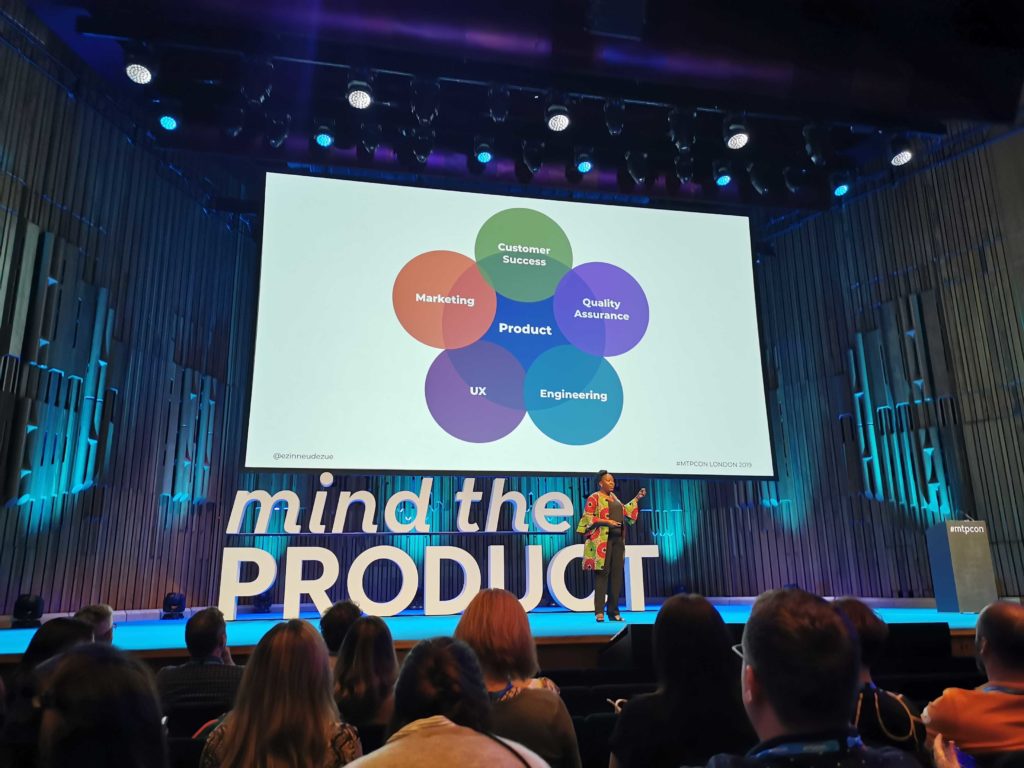
It’s important to remember you are working with humans.
“Slow down and put our humanness in the forefront of your interactions.”
Relentlessly focus on impact.
We know about outcomes, we know about outputs… but we have yet to learn about impact.
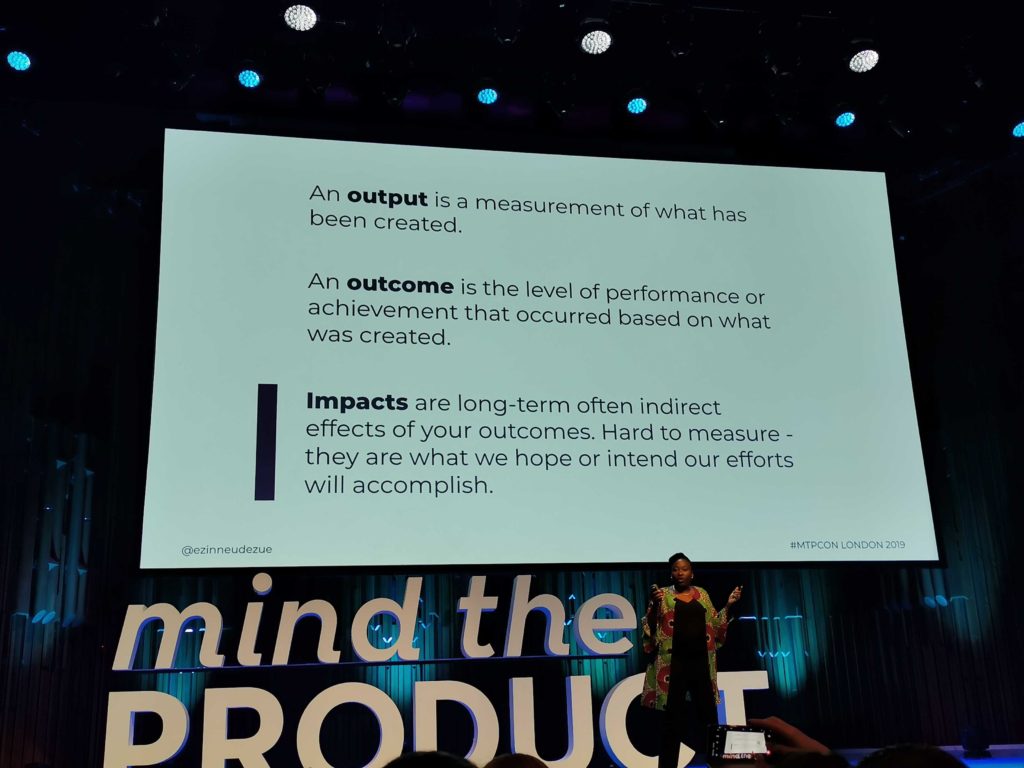
Is there a better or faster way to achieve things? Most importantly – was it all worth it?
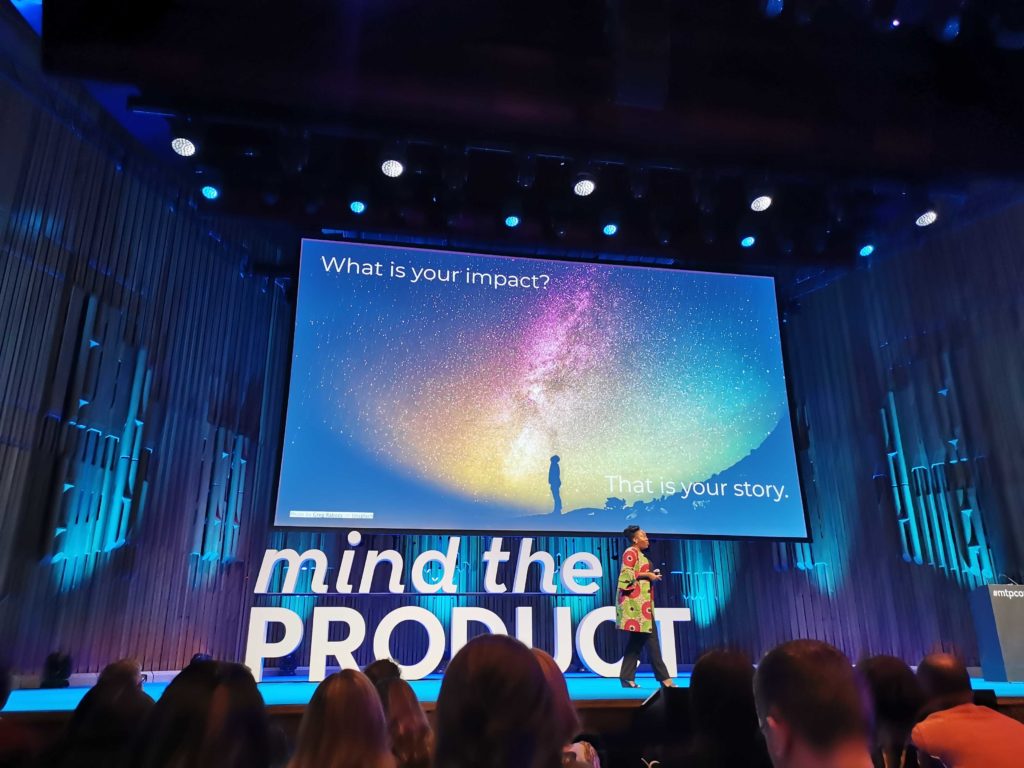
Seek clarity in your impact and convey it. Be intellectually honest, link up to value.
Get someone in the rom to challenge you. Common topic today.
Develop continuous empathy for your target customers
Listening is not empathy – it is part of it. Walk in other’s shoes, be curious.
Talk to people, ask questions!
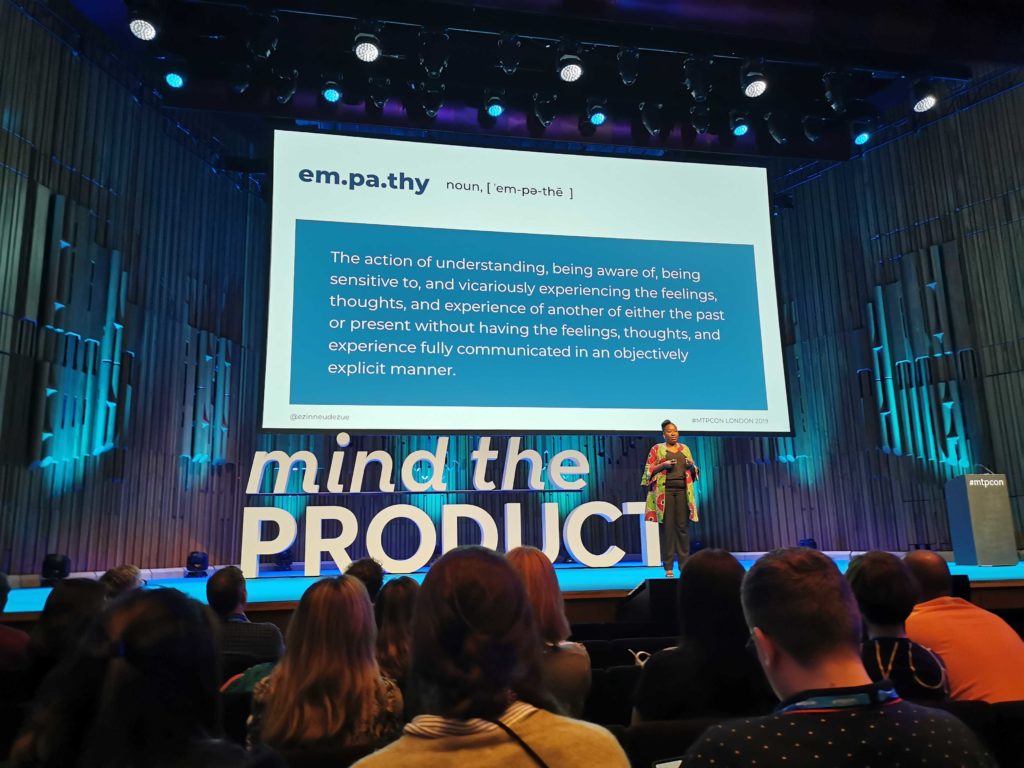
Empathy is:
- Anticipating needs
- Industry knowledge
- Support calls
- Onboarding
- Customer experience
- Market research
- Customer development
- Bugs
To be a true advocate, watch people – but do it because you care about the customer. It’ll only make you a better product manager and help you build for tomorrow, not today.
“Embody your role as the customer’s advocate. Evolve with your customer.”
Deliberately curate frameworks and systems for the craft
Respect the craft, do the work.
Use mental models that help with decision making, don’t assume the framework will do the work for you. Make it yours.
There is no hack for this. There is no quick workaround. If you read the book, use it, put things you learn into practice.
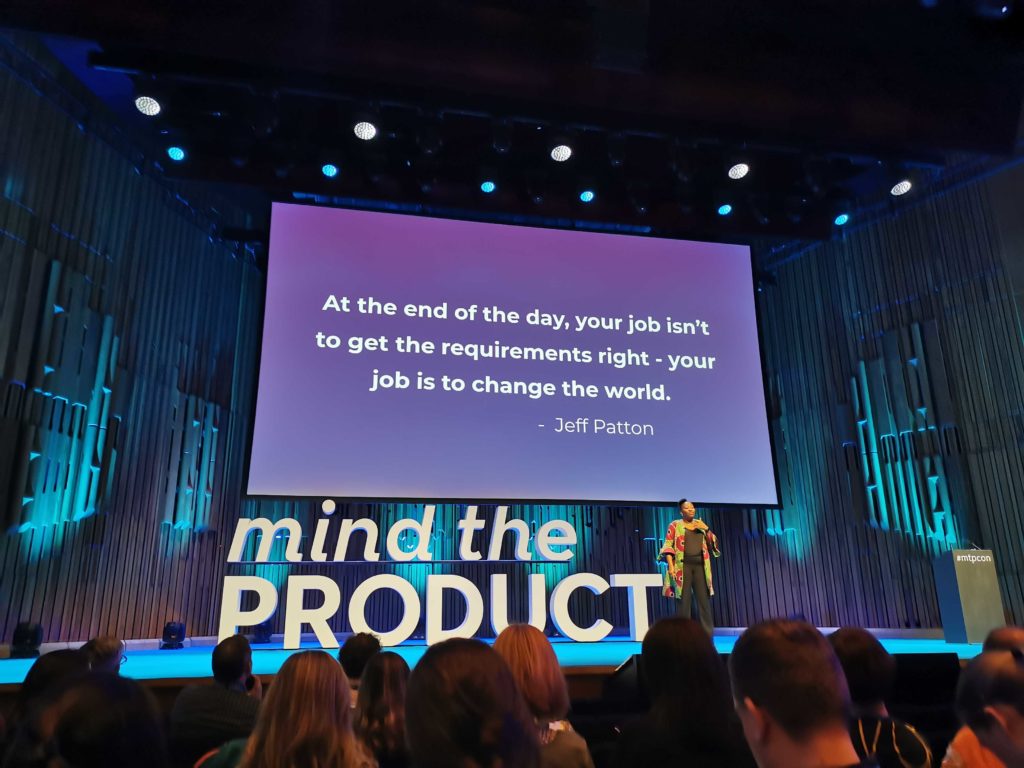
Product management is a team sport. If you want to lead, it’s important that you invest in understanding the people you work with. Focus on impact, that is your story. Be an advocate for your customer. And remember… do the work.
Brendan Dawes
Interaction Designer
Last but not least, Brendan Dawes took to the stage.
Like many of us, Brendan’s mom doesn’t know what he does for a living. He tried to explain it and it turned out something like this.
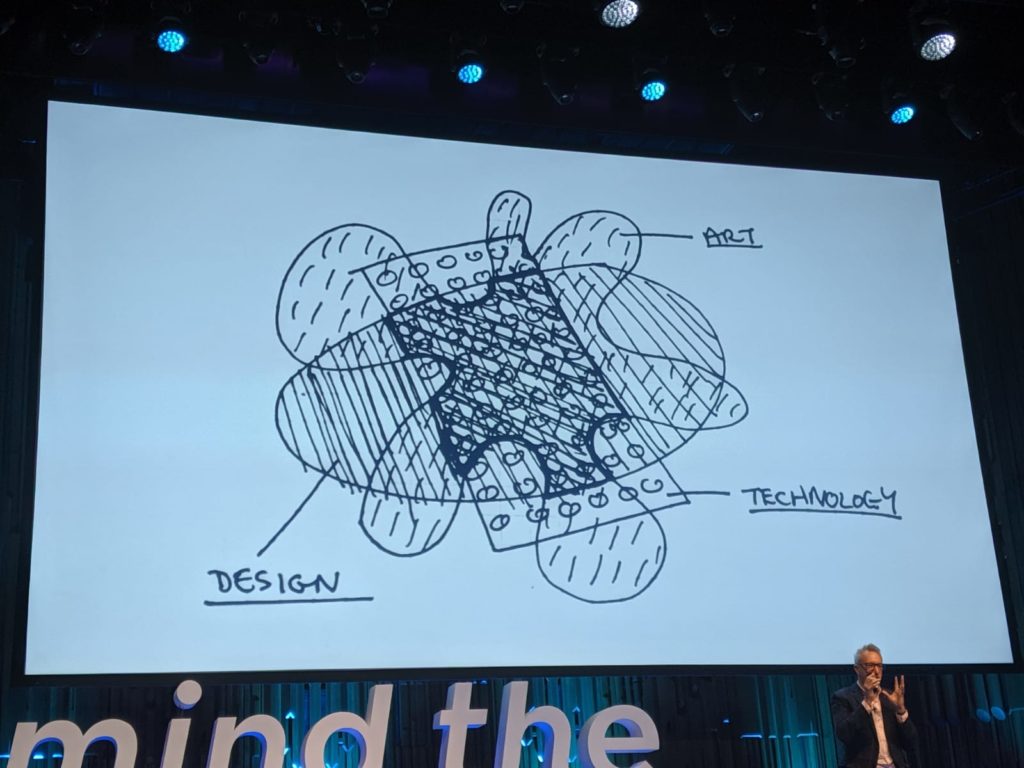
So what does he do? Well, he runs experiments. These experiments will raise patterns that will power deviations.
“All well-made products are made up of perfect timing mechanisms.”
If we use universal themes to connect with people. People aren’t interested in technology per say, it’s a conduit to communicate, says Brendan.
Brendan is now showing us the value of analogue, human pleasures. Combining these with digital can lead to amazing things- as the Happiness Machine (which prints receipts or happy online stories) demonstrates.
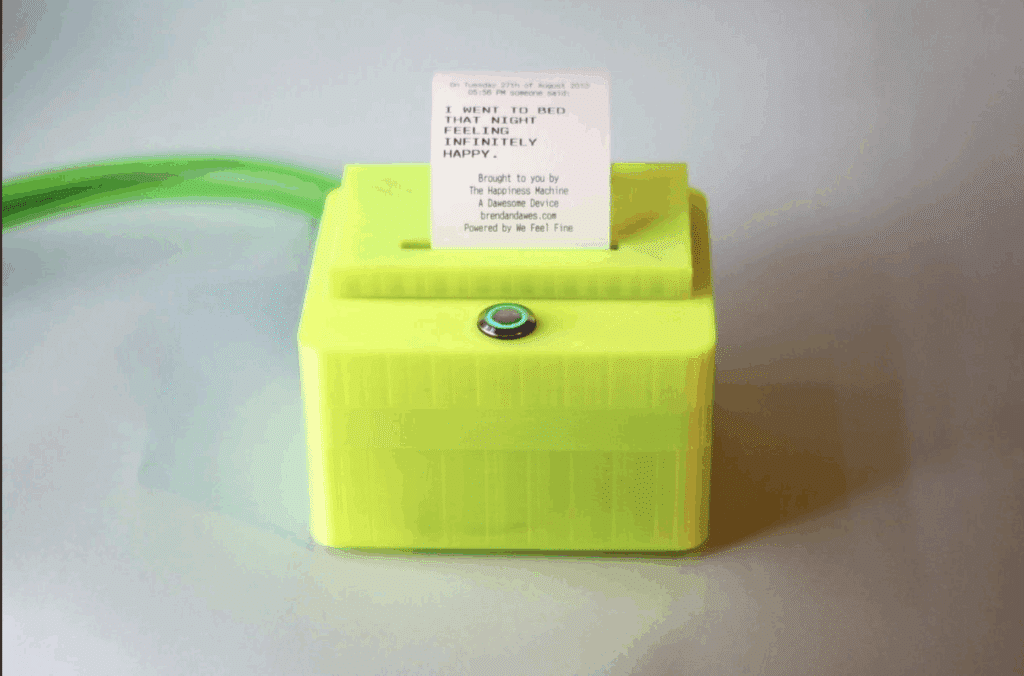
We are also seeing some cool data visualizations of different Twitter feeds, including Manchester United winning!
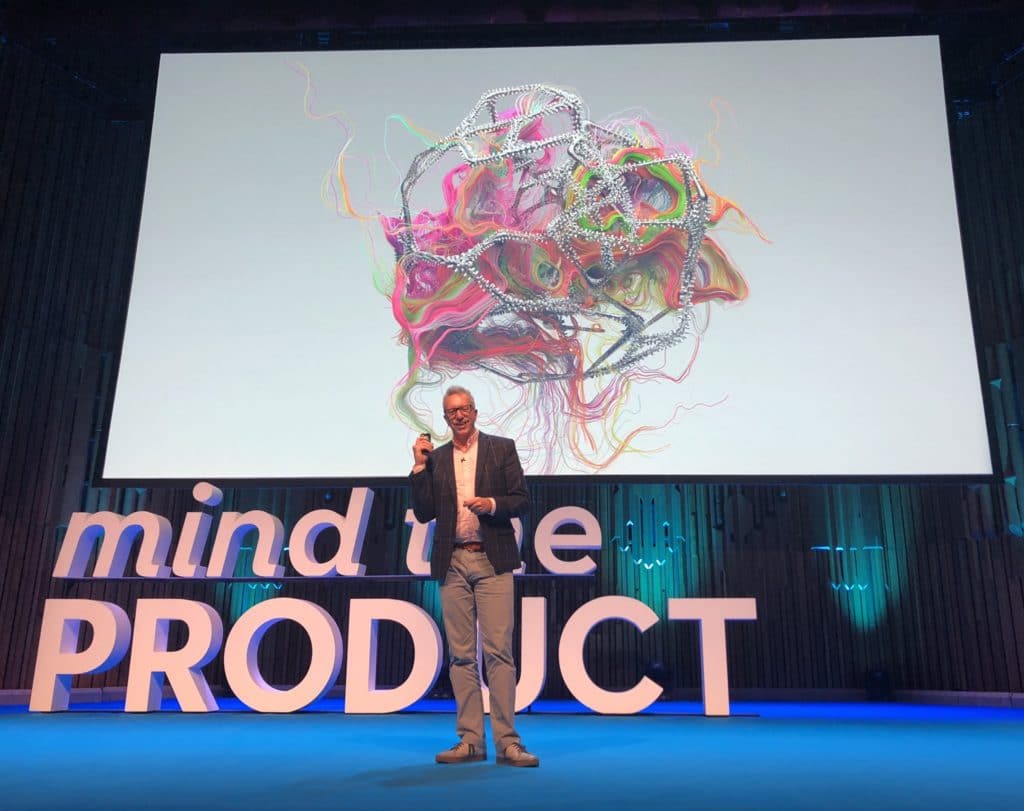
Now showing off his creative process (seem familiar, anyone?)
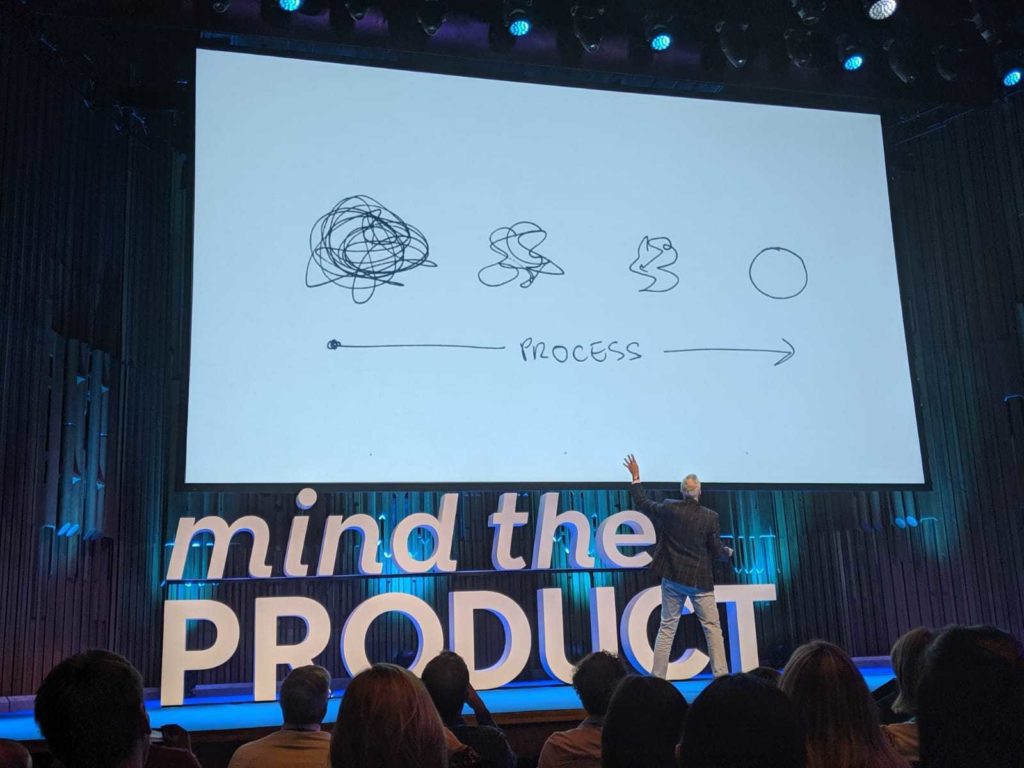
Thank you all for a great Mind The Product.

Thank you so much for the summary 🙂